SGS Thomson Microelectronics ST72C124J2, ST72C334N4, ST72C334N2, ST72C334J4, ST72C334J2 Datasheet
...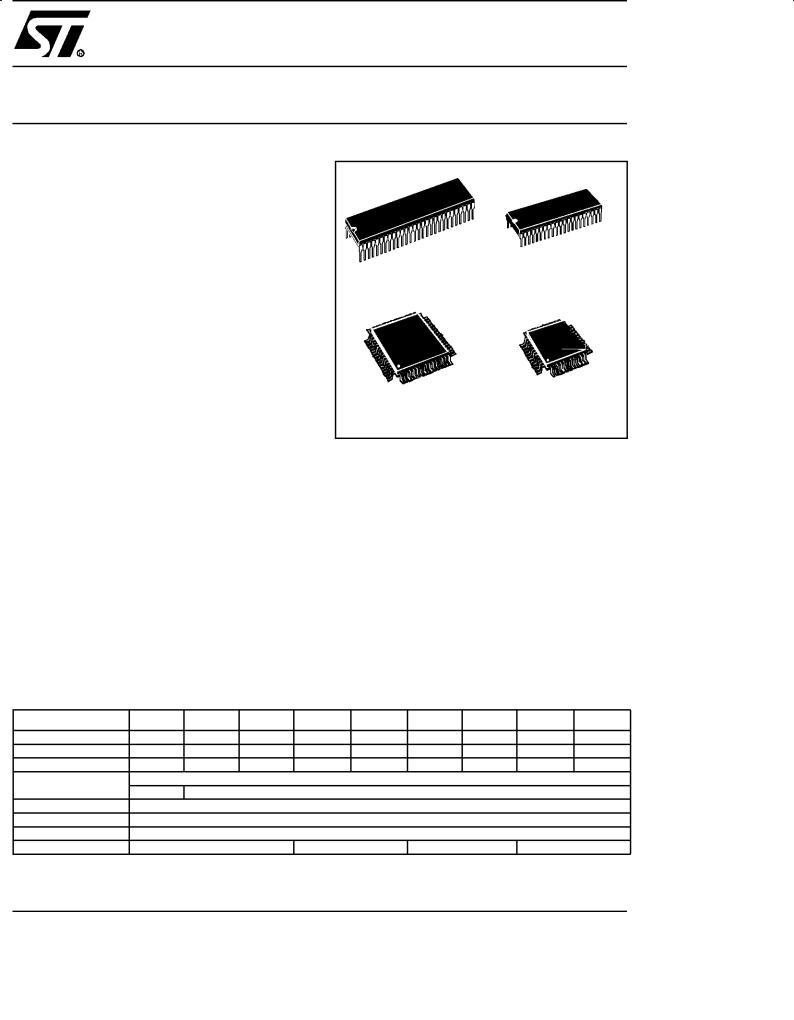
ST72334J/N,
ST72314J/N, ST72124J
8-BIT MCU WITH SINGLE VOLTAGE FLASH MEMORY, ADC, 16-BIT TIMERS, SPI, SCI INTERFACES
|
|
|
PRELIMINARY DATA |
■ |
Memories |
|
|
|
± 8K or 16K Program memory (ROM or single |
|
|
|
voltage FLASH) with read-out protection and |
|
|
|
in-situ programming (remote ISP) |
|
|
|
± 256 bytes EEPROM Data memory (with read- |
|
|
|
out protection option in ROM devices) |
|
|
|
± 384 or 512 bytes RAM |
|
|
■ |
Clock, Reset and Supply Management |
PSDIP56 |
PSDIP42 |
|
± Enhanced reset system |
||
|
|
||
|
|
|
±Enhanced low voltage supply supervisor with 3 programmable levels
±Clock sources: crystal/ceramic resonator oscillators or RC oscillators, external clock, backup Clock Security System
±4 Power Saving Modes: Halt, Active-Halt, Wait and Slow
±Beep and clock-out capabilities
■Interrupt Management
±10 interrupt vectors plus TRAP and RESET
±15 external interrupt lines (4 vectors)
■44 or 32 I/O Ports
±44 or 32 multifunctional bidirectional I/O lines:
±21 or 19 alternate function lines
±12 or 8 high sink outputs
■4 Timers
±Configurable watchdog timer
±Realtime base
±Two 16-bit timers with: 2 input captures (only one on timer A), 2 output compares (only one on timer A), External clock input on timer A, PWM and Pulse generator modes
■2 Communications Interfaces
±SPI synchronous serial interface
±SCI asynchronous serial interface
Device Summary
TQFP64 |
TQFP44 |
14 x 14 |
10 x 10 |
■1 Analog Peripheral
±8-bit ADC with 8 input channels (6 only on ST72334Jx, not available on ST72124J2)
■Instruction Set
±8-bit data manipulation
±63 basic instructions
±17 main addressing modes
±8 x 8 unsigned multiply instruction
±True bit manipulation
■Development Tools
±Full hardware/software development package
Features ST72124J2 ST72314J2 ST72314J4 ST72314N2 ST72314N4 ST72334J2 ST72334J4 ST72334N2 ST72334N4
Program memory - bytes |
8K |
8K |
16K |
8K |
16K |
8K |
16K |
8K |
16K |
RAM (stack) - bytes |
384 (256) |
384 (256) |
512 (256) |
384 (256) |
512 (256) |
384 (256) |
512 (256) |
384 (256) |
512 (256) |
EEPROM - bytes |
- |
- |
- |
- |
- |
256 |
256 |
256 |
256 |
Peripherals |
|
|
|
Watchdog, Two 16-bit Timers, SPI, SCI |
|
|
|
||
- |
|
|
|
ADC |
|
|
|
||
|
|
|
|
|
|
|
|||
Operating Supply |
|
|
|
|
3.0V to 5.5 V |
|
|
|
|
CPU Frequency |
|
|
|
Up to 8 MHz (with up to 16 MHz oscillator) |
|
|
|||
Operating Temperature |
|
|
-40°C to +85°C (-40°C to +105/125°C optional) |
|
|
||||
Packages |
TQFP44 / SDIP42 |
TQFP64 / SDIP56 |
TQFP44 / SDIP42 |
TQFP64 / SDIP56 |
|||||
|
|
|
|
|
|
|
|
|
Rev. 2.1 |
May 2000 |
|
|
|
|
|
|
|
|
1/148 |
This is preliminary information on a new product in development or undergoing evaluation. Details are subject to change without notice.

Table of Contents
1 PREAMBLE: ST72C334 VERSUS ST72E331 SPECIFICATION . . . . . . . . . . . . . . . . . . . . . . . . . 4 2 INTRODUCTION . . . . . . . . . . . . . . . . . . . . . . . . . . . . . . . . . . . . . . . . . . . . . . . . . . . . . . . . . . . . . . 5 3 PIN DESCRIPTION . . . . . . . . . . . . . . . . . . . . . . . . . . . . . . . . . . . . . . . . . . . . . . . . . . . . . . . . . . . . 6 4 REGISTER & MEMORY MAP . . . . . . . . . . . . . . . . . . . . . . . . . . . . . . . . . . . . . . . . . . . . . . . . . . . 12 5 FLASH PROGRAM MEMORY . . . . . . . . . . . . . . . . . . . . . . . . . . . . . . . . . . . . . . . . . . . . . . . . . . 16
5.1 INTRODUCTION . . . . . . . . . . . . . . . . . . . . . . . . . . . . . . . . . . . . . . . . . . . . . . . . . . . . . . . 16 5.2 MAIN FEATURES . . . . . . . . . . . . . . . . . . . . . . . . . . . . . . . . . . . . . . . . . . . . . . . . . . . . . . 16 5.3 STRUCTURAL ORGANISATION . . . . . . . . . . . . . . . . . . . . . . . . . . . . . . . . . . . . . . . . . . 16 5.4 IN-SITU PROGRAMMING (ISP) MODE . . . . . . . . . . . . . . . . . . . . . . . . . . . . . . . . . . . . . 16 5.5 MEMORY READ-OUT PROTECTION . . . . . . . . . . . . . . . . . . . . . . . . . . . . . . . . . . . . . . 16
6 DATA EEPROM . . . . . . . . . . . . . . . . . . . . . . . . . . . . . . . . . . . . . . . . . . . . . . . . . . . . . . . . . |
. . . . 17 |
|
6.1 |
INTRODUCTION . . . . . . . . . . . . . . . . . . . . . . . . . . . . . . . . . . . . . . . . . . . . . . . . . . . |
. . . . 17 |
6.2 |
MAIN FEATURES . . . . . . . . . . . . . . . . . . . . . . . . . . . . . . . . . . . . . . . . . . . . . . . . . . |
. . . . 17 |
6.3 |
MEMORY ACCESS . . . . . . . . . . . . . . . . . . . . . . . . . . . . . . . . . . . . . . . . . . . . . . . . . |
. . . . 18 |
6.4 |
POWER SAVING MODES . . . . . . . . . . . . . . . . . . . . . . . . . . . . . . . . . . . . . . . . . . . |
. . . . 19 |
6.5 |
ACCESS ERROR HANDLING . . . . . . . . . . . . . . . . . . . . . . . . . . . . . . . . . . . . . . . . |
. . . . 19 |
6.6 |
REGISTER DESCRIPTION . . . . . . . . . . . . . . . . . . . . . . . . . . . . . . . . . . . . . . . . . . . |
. . . . 20 |
6.7 |
READ-OUT PROTECTION OPTION . . . . . . . . . . . . . . . . . . . . . . . . . . . . . . . . . . . . |
. . . . 20 |
7 CENTRAL PROCESSING UNIT . . . . . . . . . . . . . . . . . . . . . . . . . . . . . . . . . . . . . . . . . . . . . |
. . . . 21 |
|
7.1 |
INTRODUCTION . . . . . . . . . . . . . . . . . . . . . . . . . . . . . . . . . . . . . . . . . . . . . . . . . . . |
. . . . 21 |
7.2 |
MAIN FEATURES . . . . . . . . . . . . . . . . . . . . . . . . . . . . . . . . . . . . . . . . . . . . . . . . . . |
. . . . 21 |
7.3 |
CPU REGISTERS . . . . . . . . . . . . . . . . . . . . . . . . . . . . . . . . . . . . . . . . . . . . . . . . . . |
. . . . 21 |
8 SUPPLY, RESET AND CLOCK MANAGEMENT . . . . . . . . . . . . . . . . . . . . . . . . . . . . . . . . |
. . . . 24 |
|
8.1 |
LOW VOLTAGE DETECTOR (LVD) . . . . . . . . . . . . . . . . . . . . . . . . . . . . . . . . . . . . |
. . . . 25 |
8.2 |
RESET SEQUENCE MANAGER (RSM) . . . . . . . . . . . . . . . . . . . . . . . . . . . . . . . . . |
. . . . 26 |
8.3 |
MULTI-OSCILLATOR (MO) . . . . . . . . . . . . . . . . . . . . . . . . . . . . . . . . . . . . . . . . . . . |
. . . . 28 |
8.4 |
CLOCK SECURITY SYSTEM (CSS) . . . . . . . . . . . . . . . . . . . . . . . . . . . . . . . . . . . . |
. . . . 29 |
8.5 |
SUPPLY, RESET AND CLOCK REGISTER DESCRIPTION . . . . . . . . . . . . . . . . . |
. . . . 30 |
9 INTERRUPTS . . . . . . . . . . . . . . . . . . . . . . . . . . . . . . . . . . . . . . . . . . . . . . . . . . . . . . . . . . . |
. . . . 31 |
|
9.1 |
NON MASKABLE SOFTWARE INTERRUPT . . . . . . . . . . . . . . . . . . . . . . . . . . . . . |
. . . . 31 |
9.2 |
EXTERNAL INTERRUPTS . . . . . . . . . . . . . . . . . . . . . . . . . . . . . . . . . . . . . . . . . . . |
. . . . 31 |
9.3 |
PERIPHERAL INTERRUPTS . . . . . . . . . . . . . . . . . . . . . . . . . . . . . . . . . . . . . . . . . |
. . . . 31 |
10 POWER SAVING MODES . . . . . . . . . . . . . . . . . . . . . . . . . . . . . . . . . . . . . . . . . . . . . . . . |
. . . . 33 |
|
10.1 |
INTRODUCTION . . . . . . . . . . . . . . . . . . . . . . . . . . . . . . . . . . . . . . . . . . . . . . . . . . . |
. . . . 33 |
10.2 |
SLOW MODE . . . . . . . . . . . . . . . . . . . . . . . . . . . . . . . . . . . . . . . . . . . . . . . . . . . . . |
. . . . 33 |
10.3 |
WAIT MODE . . . . . . . . . . . . . . . . . . . . . . . . . . . . . . . . . . . . . . . . . . . . . . . . . . . . . . |
. . . . 34 |
10.4 |
ACTIVE-HALT AND HALT MODES . . . . . . . . . . . . . . . . . . . . . . . . . . . . . . . . . . . . |
. . . . 35 |
11 I/O PORTS . . . . . . . . . . . . . . . . . . . . . . . . . . . . . . . . . . . . . . . . . . . . . . . . . . . . . . . . . . . . . |
. . . . 37 |
|
11.1 |
INTRODUCTION . . . . . . . . . . . . . . . . . . . . . . . . . . . . . . . . . . . . . . . . . . . . . . . . . . . |
. . . . 37 |
11.2 |
FUNCTIONAL DESCRIPTION . . . . . . . . . . . . . . . . . . . . . . . . . . . . . . . . . . . . . . . . |
. . . . 37 |
|
|
148 |
11.3 |
I/O PORT IMPLEMENTATION . . . . . . . . . . . . . . . . . . . . . . . . . . . . . . . . . . . . . . . . |
. . . . 40 |
11.4 |
LOW POWER MODES . . . . . . . . . . . . . . . . . . . . . . . . . . . . . . . . . . . . . . . . . . . . . . |
. . . . 41 |
2/148

|
Table of Contents |
|
11.5 |
INTERRUPTS . . . . . . . . . . . . . . . . . . . . . . . . . . . . . . . . . . . . . . . . . . . . . . . . . . . . . . . . . |
41 |
12 MISCELLANEOUS REGISTERS . . . . . . . . . . . . . . . . . . . . . . . . . . . . . . . . . . . . . . . . . . . . . . . |
44 |
|
12.1 |
I/O PORT INTERRUPT SENSITIVITY . . . . . . . . . . . . . . . . . . . . . . . . . . . . . . . . . . . . . . |
44 |
12.2 |
I/O PORT ALTERNATE FUNCTIONS . . . . . . . . . . . . . . . . . . . . . . . . . . . . . . . . . . . . . . . |
44 |
12.3 |
REGISTERS DESCRIPTION . . . . . . . . . . . . . . . . . . . . . . . . . . . . . . . . . . . . . . . . . . . . . |
45 |
13 ON-CHIP PERIPHERALS . . . . . . . . . . . . . . . . . . . . . . . . . . . . . . . . . . . . . . . . . . . . . . . . . . . . . |
47 |
|
13.1 |
WATCHDOG TIMER (WDG) . . . . . . . . . . . . . . . . . . . . . . . . . . . . . . . . . . . . . . . . . . . . . . |
47 |
13.2 |
MAIN CLOCK CONTROLLER WITH REAL TIME CLOCK TIMER (MCC/RTC) . . . . . . . |
50 |
13.3 |
16-BIT TIMER . . . . . . . . . . . . . . . . . . . . . . . . . . . . . . . . . . . . . . . . . . . . . . . . . . . . . . . . . |
52 |
13.4 |
SERIAL PERIPHERAL INTERFACE (SPI) . . . . . . . . . . . . . . . . . . . . . . . . . . . . . . . . . . . |
70 |
13.5 |
SERIAL COMMUNICATIONS INTERFACE (SCI) . . . . . . . . . . . . . . . . . . . . . . . . . . . . . . |
83 |
13.6 |
8-BIT A/D CONVERTER (ADC) . . . . . . . . . . . . . . . . . . . . . . . . . . . . . . . . . . . . . . . . . . . |
95 |
14 INSTRUCTION SET . . . . . . . . . . . . . . . . . . . . . . . . . . . . . . . . . . . . . . . . . . . . . . . . . . . . . . . . . |
99 |
|
14.1 ST7 ADDRESSING MODES . . . . . . . . . . . . . . . . . . . . . . . . . . . . . . . . . . . . . . . . . . . . . . 99 14.2 INSTRUCTION GROUPS . . . . . . . . . . . . . . . . . . . . . . . . . . . . . . . . . . . . . . . . . . . . . . . 102
15 ELECTRICAL CHARACTERISTICS . . . . . . . . . . . . . . . . . . . . . . . . . . . . . . . . . . . . . . . . . . . . 105
15.1 PARAMETER CONDITIONS . . . . . . . . . . . . . . . . . . . . . . . . . . . . . . . . . . . . . . . . . . . . . 105 15.2 ABSOLUTE MAXIMUM RATINGS . . . . . . . . . . . . . . . . . . . . . . . . . . . . . . . . . . . . . . . . 106 15.3 OPERATING CONDITIONS . . . . . . . . . . . . . . . . . . . . . . . . . . . . . . . . . . . . . . . . . . . . . 107 15.4 SUPPLY CURRENT CHARACTERISTICS . . . . . . . . . . . . . . . . . . . . . . . . . . . . . . . . . . 110 15.5 CLOCK AND TIMING CHARACTERISTICS . . . . . . . . . . . . . . . . . . . . . . . . . . . . . . . . . 113 15.6 MEMORY CHARACTERISTICS . . . . . . . . . . . . . . . . . . . . . . . . . . . . . . . . . . . . . . . . . . 119 15.7 EMC CHARACTERISTICS . . . . . . . . . . . . . . . . . . . . . . . . . . . . . . . . . . . . . . . . . . . . . . 120 15.8 I/O PORT PIN CHARACTERISTICS . . . . . . . . . . . . . . . . . . . . . . . . . . . . . . . . . . . . . . . 125 15.9 CONTROL PIN CHARACTERISTICS . . . . . . . . . . . . . . . . . . . . . . . . . . . . . . . . . . . . . . 128 15.10 TIMER PERIPHERAL CHARACTERISTICS . . . . . . . . . . . . . . . . . . . . . . . . . . . . . . . . . 131 15.11 COMMUNICATION INTERFACE CHARACTERISTICS . . . . . . . . . . . . . . . . . . . . . . . . 132 15.12 8-BIT ADC CHARACTERISTICS . . . . . . . . . . . . . . . . . . . . . . . . . . . . . . . . . . . . . . . . . 135
16 PACKAGE CHARACTERISTICS . . . . . . . . . . . . . . . . . . . . . . . . . . . . . . . . . . . . . . . . . . . . . . |
137 |
16.1 PACKAGE MECHANICAL DATA . . . . . . . . . . . . . . . . . . . . . . . . . . . . . . . . . . . . . . . . . 137 16.2 THERMAL CHARACTERISTICS . . . . . . . . . . . . . . . . . . . . . . . . . . . . . . . . . . . . . . . . . 139 16.3 SOLDERING AND GLUEABILITY INFORMATION . . . . . . . . . . . . . . . . . . . . . . . . . . . . 140 16.4 PACKAGE/SOCKET FOOTPRINT PROPOSAL . . . . . . . . . . . . . . . . . . . . . . . . . . . . . . 141
17 DEVICE CONFIGURATION AND ORDERING INFORMATION . . . . . . . . . . . . . . . . . . . . . . . 143
17.1 OPTION BYTES . . . . . . . . . . . . . . . . . . . . . . . . . . . . . . . . . . . . . . . . . . . . . . . . . . . . . . 143 17.2 DEVELOPMENT TOOLS . . . . . . . . . . . . . . . . . . . . . . . . . . . . . . . . . . . . . . . . . . . . . . . 146
18 SUMMARY OF CHANGES . . . . . . . . . . . . . . . . . . . . . . . . . . . . . . . . . . . . . . . . . . . . . . . . . . . |
147 |
3/148

ST72334J/N, ST72314J/N, ST72124J
1 PREAMBLE: ST72C334 VERSUS ST72E331 SPECIFICATION
New Features available on the ST72C334
■8 or 16K FLASH/ROM with In-Situ Programming and Read-out protection
■New ADC with a better accuracy and conversion time
■New configurable Clock, Reset and Supply system
■New power saving mode with real time base: Active Halt
■Beep capability on PF1
■New interrupt source: Clock security system (CSS) or Main clock controller (MCC)
ST72C334 I/O Configuration and Pinout
■Same pinout as ST72E331
■PA6 and PA7 are true open drain I/O ports without pull-up (same as ST72E331)
■PA3, PB3, PB4 and PF2 have no pull-up configuration (all I/Os present on TQFP44)
■PA5:4, PC3:2, PE7:4 and PF7:6 have high sink capabilities (20mA on N-buffer, 2mA on P-buffer and pull-up). On the ST72E331, all these pads (except PA5:4) were 2mA push-pull pads without high sink capabilities. PA4 and PA5 were 20mA true open drains.
New Memory Locations in ST72C334
■20h: MISCR register becomes MISCR1 register (naming change)
■29h: new control/status register for the MCC module
■2Bh: new control/status register for the Clock, Reset and Supply control. This register replaces the WDGSR register keeping the WDOGF flag compatibility.
■40h: new MISCR2 register
4/148
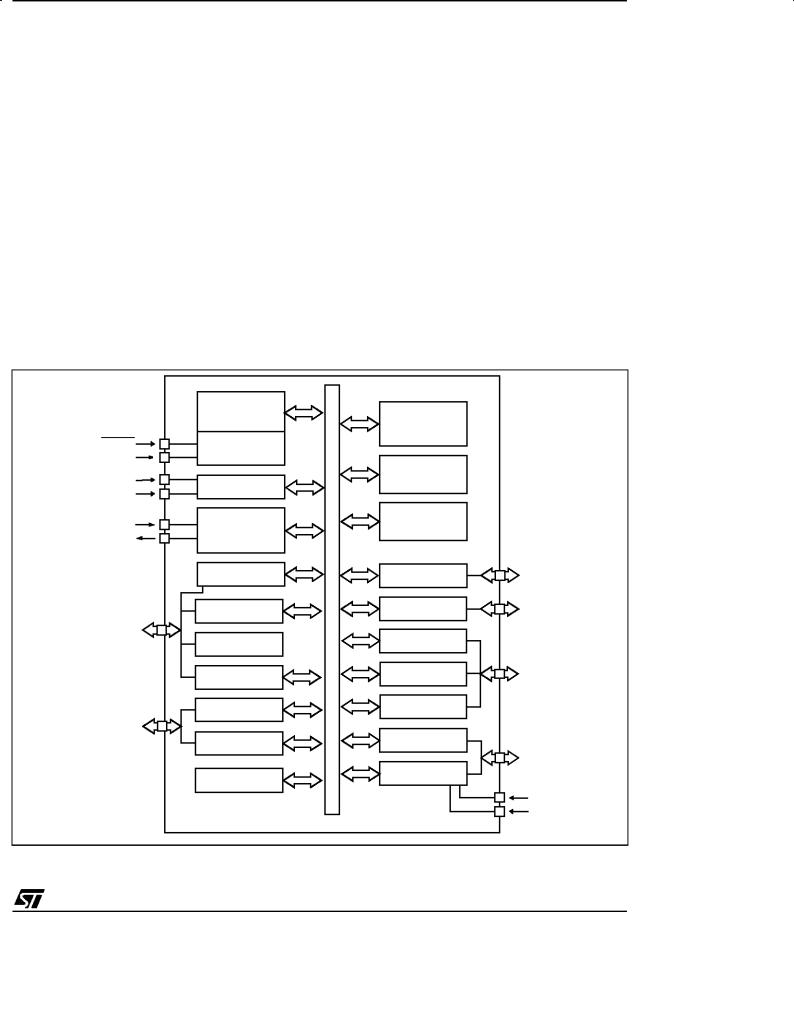
2 INTRODUCTION
The ST72334J/N, ST72314J/N and ST72124J devices are members of the ST7 microcontroller family. They can be grouped as follows:
± ST72334J/N devices are designed for mid-range applications with Data EEPROM, ADC, SPI and SCI interface capabilities.
±ST72314J/N devices target the same range of applications but without Data EEPROM.
±ST72124J devices are for applications that do not need Data EEPROM and the ADC peripheral.
All devices are based on a common industrystandard 8-bit core, featuring an enhanced instruction set.
The ST72C334J/N, ST72C314J/N and ST72C124J versions feature single-voltage
Figure 1. General Block Diagram
ST72334J/N, ST72314J/N, ST72124J
FLASH memory with byte-by-byte In-Situ Programming (ISP) capability.
Under software control, all devices can be placed in WAIT, SLOW, ACTIVE-HALT or HALT mode, reducing power consumption when the application is in idle or standby state.
The enhanced instruction set and addressing modes of the ST7 offer both power and flexibility to software developers, enabling the design of highly efficient and compact application code. In addition to standard 8-bit data management, all ST7 microcontrollers feature true bit manipulation, 8x8 unsigned multiplication and indirect addressing modes.
For easy reference, all parametric data are located in Section 15 on page 105.
RESET
ISPSEL
VDD
VSS
OSC1
OSC2
PF7,6,4,2:0 (6-BIT)
PE7:0 (6-BIT for N versions)
(2-BIT for J versions)
8-BIT CORE
ALU
CONTROL
LVD
MULTI OSC
+
CLOCK FILTER
MCC/RTC
PORT F
TIMER A
BEEP
PORT E
SCI
WATCHDOG
BUS DATA AND ADDRESS
PROGRAM
MEMORY (8K or 16K Bytes)
RAM
(384 or 512 Bytes)
EEPROM
(256 Bytes)
PORT A |
PA7:0 |
|
(8-BIT for N versions) |
||
|
||
|
(5-BIT for J versions) |
|
PORT B |
PB7:0 |
|
(8-BIT for N versions) |
||
|
||
|
(5-BIT for J versions) |
|
PORT C |
|
|
TIMER B |
PC7:0 |
|
(8-BIT) |
||
|
||
SPI |
|
|
PORT D |
|
|
|
PD7:0 |
|
8-BIT ADC |
(8-BIT for N versions) |
|
(6-BIT for J versions) |
||
|
VDDA |
|
|
VSSA |
5/148
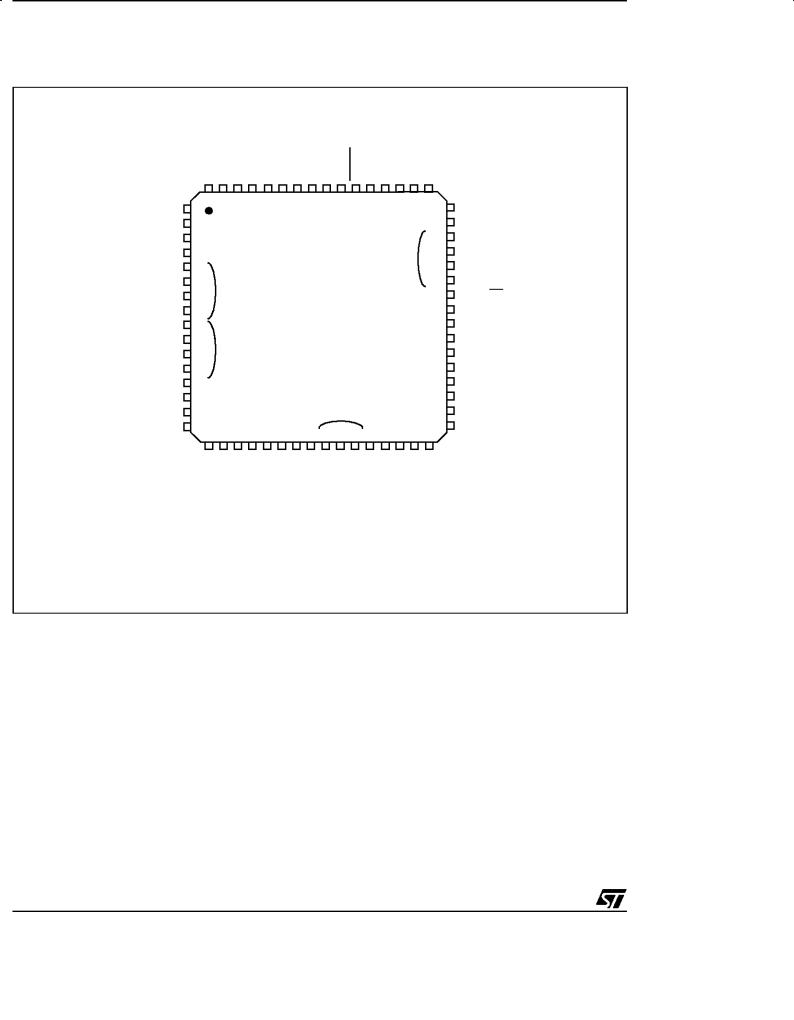
ST72334J/N, ST72314J/N, ST72124J
3 PIN DESCRIPTION
Figure 2. 64-Pin TQFP Package Pinout (N versions)
(HS) PE4
(HS) PE5
(HS) PE6
(HS) PE7
PB0
PB1
PB2
PB3
PB4
PB5
PB6
PB7
AIN0 / PD0 AIN1 / PD1
AIN2 / PD2
AIN3 / PD3
NC |
NC PE1/ RDI PE0/ TDO |
V |
OSC1 OSC2 |
V |
NC |
NC |
RESET |
ISPSEL PA7(HS) |
PA6(HS) |
PA5(HS) |
PA4(HS) |
|
|
|
2 |
|
2 |
|
|
|
|
|
|
|
|
|
|
DD |
|
SS |
|
|
|
|
|
|
|
|
64 63 62 61 60 59 58 57 56 55 54 53 52 51 50 49 |
VSS_1 |
|||||||||||
1 |
|
|
|
|
|
|
|
|
|
|
48 |
|
2 |
|
|
|
|
|
|
|
|
|
|
47 |
VDD_1 |
3 |
|
46 |
|
4 |
|
45 |
|
5 |
|
ei0 |
|
|
44 |
||
6 |
ei2 |
43 |
|
7 |
42 |
||
|
|||
8 |
|
41 |
|
9 |
|
40 |
|
10 |
ei3 |
39 |
|
11 |
38 |
||
|
|||
12 |
|
37 |
|
13 |
|
36 |
|
14 |
|
35 |
|
15 |
ei1 |
34 |
|
16 |
|
33 |
17 18 19 20 21 22 23 24 25 26 27 28 29 30 31 32
AIN4 / PD4 |
AIN5 / PD5 |
AIN6 / PD6 |
AIN7 / PD7 |
DDA |
SSA |
DD_3 |
SS_3 |
MCO / PF0 |
BEEP / PF1 |
PF2 |
NC |
OCMP1 A / PF4 |
NC |
ICAP1 A / (HS) PF6 |
EXTCLK A / (HS) PF7 |
V |
V |
V |
V |
(HS) eix
PA3
PA2
PA1
PA0
PC7 / SS
PC6 / SCK / ISPCLK
PC5 / MOSI
PC4 / MISO / ISPDATA
PC3 (HS) / ICAP1_B
PC2 (HS) / ICAP2_B
PC1 / OCMP1_B
PC0 / OCMP2_B
VSS_0
VDD_0
20mA high sink capability associated external interrupt vector
6/148
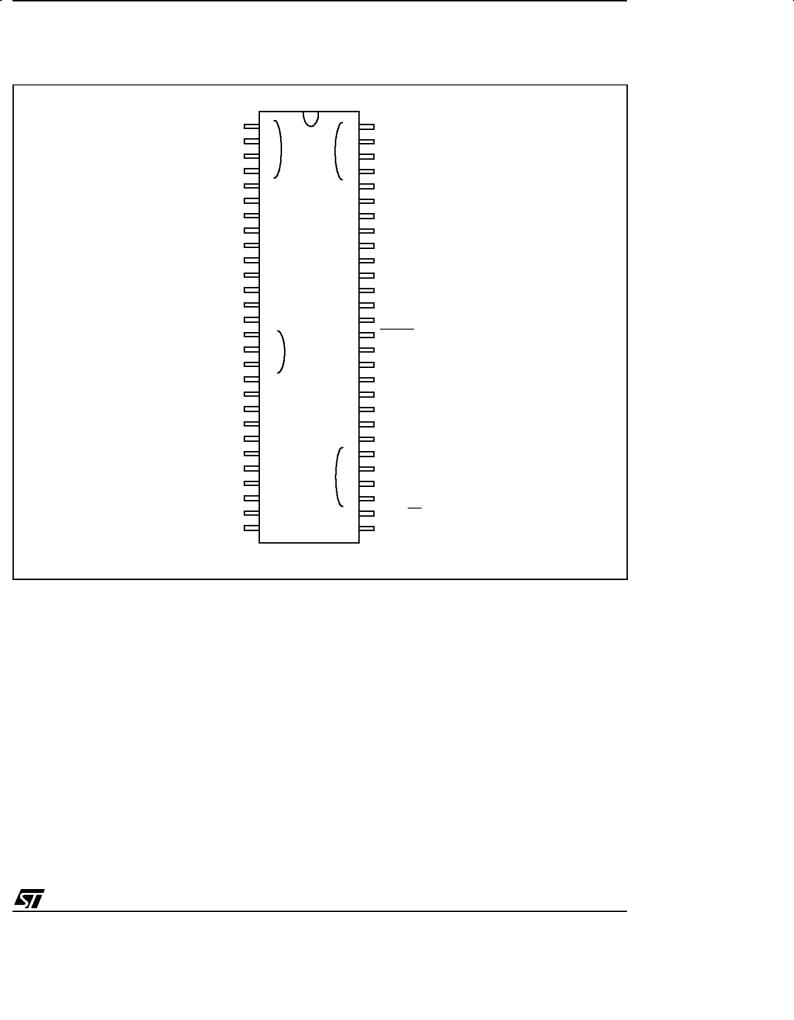
ST72334J/N, ST72314J/N, ST72124J
PIN DESCRIPTION (Cont'd)
Figure 3. 56-Pin SDIP Package Pinout (N versions)
PB4 |
1 |
|
|
56 |
PB3 |
|
PB5 |
2 |
ei3 |
ei2 |
55 |
PB2 |
|
PB6 |
3 |
54 |
PB1 |
|
||
|
|
|
||||
PB7 |
4 |
|
|
53 |
PB0 |
|
AIN0 / PD0 |
5 |
|
|
52 |
PE7 (HS) |
|
AIN1 / PD1 |
6 |
|
|
51 |
PE6 (HS) |
|
AIN2 / PD2 |
7 |
|
|
50 |
PE5 (HS) |
|
AIN3 / PD3 |
8 |
|
|
49 |
PE4 (HS) |
|
AIN4 / PD4 |
9 |
|
|
48 |
PE1 / RDI |
|
AIN5 / PD5 |
10 |
|
|
47 |
PE0 / TDO |
|
AIN6 / PD6 |
11 |
|
|
46 |
VDD_2 |
|
AIN7 / PD7 |
12 |
|
|
45 |
OSC1 |
|
VDDA |
13 |
|
|
44 |
OSC2 |
|
VSSA |
14 |
|
|
43 |
VSS_2 |
|
MCO / PF0 |
15 |
|
|
42 |
RESET |
|
BEEP / PF1 |
16 |
ei1 |
|
41 |
ISPSEL |
|
PF2 |
17 |
|
|
40 |
PA7 (HS) |
|
OCMP1_A / PF4 |
18 |
|
|
39 |
PA6 (HS)I |
|
ICAP1_A / (HS) PF6 |
19 |
|
|
38 |
PA5 (HS) |
|
EXTCLK_A / (HS) PF7 |
20 |
|
|
37 |
PA4 (HS) |
|
VDD_0 |
21 |
|
|
36 |
VSS_1 |
|
VSS_0 |
22 |
|
|
35 |
VDD_1 |
|
OCMP2_B / PC0 |
23 |
|
|
34 |
PA3 |
|
OCMP1_B / PC1 |
24 |
|
ei0 |
33 |
PA2 |
|
ICAP2_B / (HS) PC2 |
25 |
|
32 |
PA1 |
|
|
|
|
|
||||
ICAP1_B / (HS) PC3 |
26 |
|
|
31 |
PA0 |
|
ISPDATA/ MISO / PC4 |
27 |
|
|
30 |
PC7 / SS |
|
MOSI / PC5 |
28 |
|
|
29 |
PC6 / SCK / ISPCLK |
|
|
|
|
|
|
(HS) |
20mA high sink capability |
|
|
|
|
|
eix |
associated external interrupt vector |
7/148
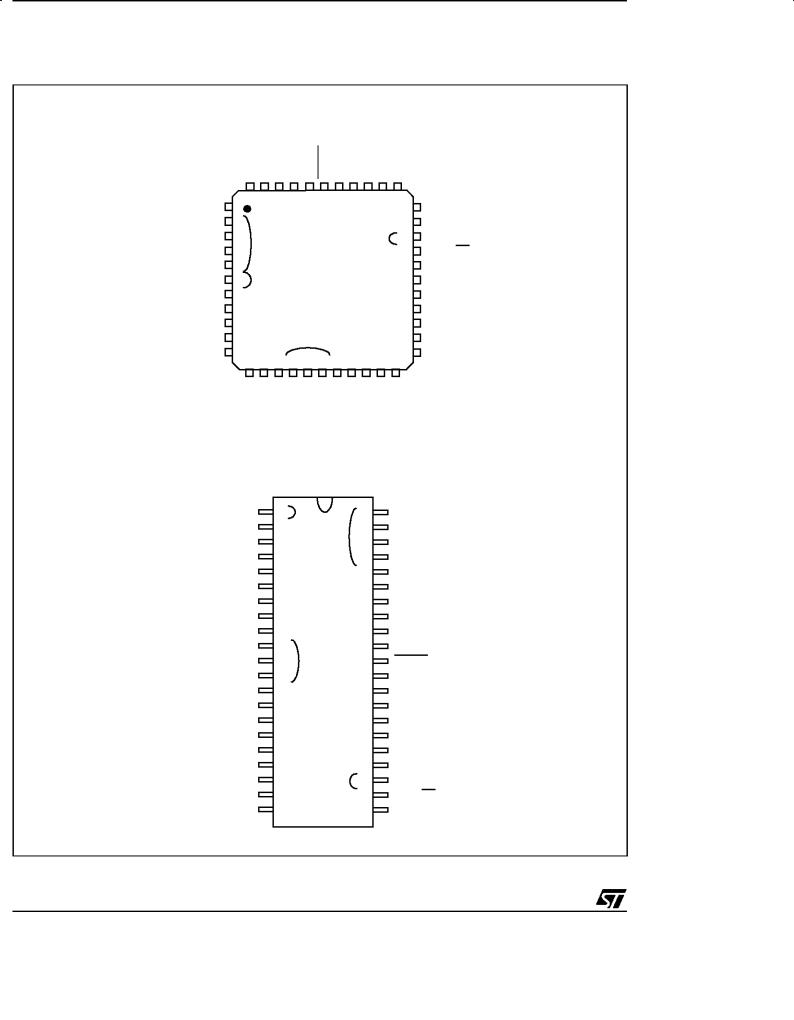
ST72334J/N, ST72314J/N, ST72124J
PIN DESCRIPTION (Cont'd)
Figure 4. 44-Pin TQFP and 42-Pin SDIP Package Pinouts (J versions)
|
PE0/ TDO |
V |
OSC1 |
OSC2 |
V |
RESET |
ISPSEL PA7(HS) PA6(HS) PA5(HS) |
PA4(HS) |
|
|
2 |
|
|
2 |
|
|
|
|
|
DD |
|
|
SS |
|
|
|
PE1 / RDI |
44 43 42 41 40 39 38 37 36 35 34 |
|||||||
1 |
|
|
|
|
|
|
33 |
|
PB0 |
2 |
|
|
|
|
|
|
32 |
PB1 |
3 |
ei2 |
|
|
|
|
ei0 |
31 |
PB2 |
4 |
|
|
|
|
|
30 |
|
|
|
|
|
|
|
|||
PB3 |
5 |
|
|
|
|
|
|
29 |
PB4 |
6 |
ei3 |
|
|
|
|
|
28 |
AIN0 / PD0 |
7 |
|
|
|
|
|
|
27 |
AIN1 / PD1 |
8 |
|
|
|
|
|
|
26 |
AIN2 / PD2 |
9 |
|
|
|
|
|
|
25 |
AIN3 / PD3 |
10 |
|
|
|
ei1 |
|
|
24 |
AIN4 / PD4 |
11 |
|
|
|
|
|
|
23 |
|
12 13 14 15 16 17 18 19 20 21 22 |
|||||||
VSS_1
VDD_1
PA3
PC7 / SS
PC6 / SCK / ISPCLK PC5 / MOSI
PC4 / MISO / ISPDATA PC3 (HS) / ICAP1_B PC2 (HS) / ICAP2_B PC1 / OCMP1_B
PC0 / OCMP2_B
/ PD5 |
DDA |
SSA |
/ PF0 |
/ PF1 |
PF2 |
/ PF4 |
V |
V |
|||||
AIN5 |
|
|
MCO |
BEEP |
|
OCMP1 A |
PB4 |
|
1 |
|
EI3 |
|
|
AIN0 / PD0 |
|
2 |
|
|
|
ei2 |
AIN1 / PD1 |
|
3 |
|
|
|
|
|
|
|
|
|
||
AIN2 / PD2 |
|
4 |
|
|
|
|
AIN3 / PD3 |
|
5 |
|
|
|
|
AIN4 / PD4 |
|
6 |
|
|
|
|
AIN5 / PD5 |
|
7 |
|
|
|
|
VDDA |
|
8 |
|
|
|
|
VSSA |
|
9 |
|
|
|
|
MCO / PF0 |
|
10 |
|
|
|
|
BEEP / PF1 |
|
11 |
|
ei1 |
|
|
PF2 |
|
12 |
|
|
|
|
OCMP1_A / PF4 |
|
13 |
|
|
|
|
ICAP1_A / (HS) PF6 |
|
14 |
|
|
|
|
EXTCLK_A / (HS) PF7 |
|
15 |
|
|
|
|
OCMP2_B / PC0 |
|
16 |
|
|
|
|
OCMP1_B / PC1 |
|
17 |
|
|
|
|
ICAP2_B/ (HS) PC2 |
|
18 |
|
|
|
|
ICAP1_B / (HS) PC3 |
|
19 |
|
|
|
ei0 |
ISPDATA / MISO / PC4 |
|
20 |
|
|
|
|
MOSI / PC5 |
|
21 |
|
|
|
|
PF6 |
PF7 |
DD 0 |
SS 0 |
|
(HS) |
(HS) |
V |
V |
|
ICAP1 A / |
EXTCLK A / |
|
|
|
|
42 |
|
PB3 |
|
|
41 |
|
PB2 |
|
|
40 |
|
PB1 |
|
|
39 |
|
PB0 |
|
|
38 |
|
PE1 / RDI |
|
|
|
|
|
|
|
37 |
|
PE0 / TDO |
|
|
36 |
|
VDD_2 |
|
|
35 |
|
OSC1 |
|
|
34 |
|
OSC2 |
|
|
33 |
|
VSS_2 |
|
|
32 |
|
RESET |
|
|
31 |
|
ISPSEL |
|
|
30 |
|
PA7 (HS) |
|
|
29 |
|
PA6 (HS) |
|
|
28 |
|
PA5 (HS) |
|
|
27 |
|
PA4 (HS) |
|
|
26 |
|
VSS_1 |
|
|
25 |
|
VDD_1 |
|
|
24 |
|
PA3 |
|
|
23 |
|
PC7 / SS |
|
|
22 |
|
PC6 / SCK / ISPCLK |
|
|
|
|
(HS) |
20mA high sink capability |
|
|
|
eix |
associated external interrupt vector |
8/148
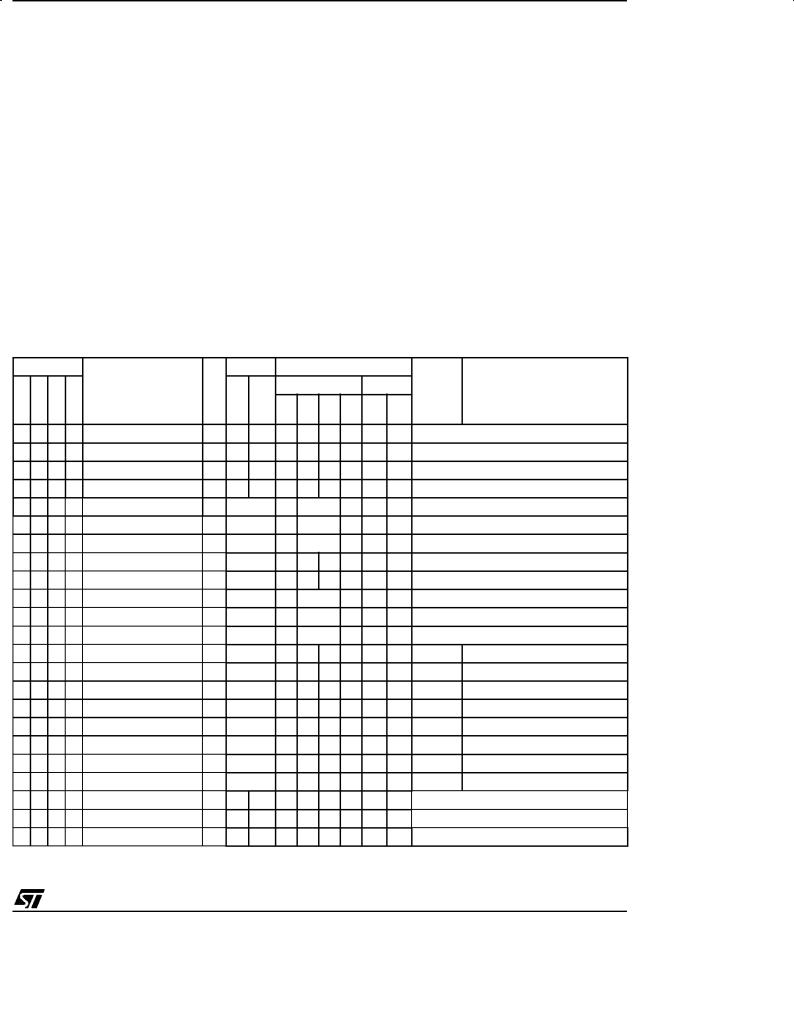
ST72334J/N, ST72314J/N, ST72124J
PIN DESCRIPTION (Cont'd)
For external pin connection guidelines, refer to Section 15 ºELECTRICAL CHARACTERISTICSº on page 105.
Legend / Abbreviations for Table 1:
Type: |
I = input, O = output, S = supply |
|
Input level: |
A = Dedicated analog input |
|
In/Output level: C = CMOS 0.3VDD/0.7VDD, |
||
|
|
CT= CMOS 0.3VDD/0.7VDD with input trigger |
Output level: |
HS = 20mA high sink (on N-buffer only) |
|
Port and control configuration: |
||
± |
Input: |
float = floating, wpu = weak pull-up, int = interrupt 1), ana = analog |
± |
Output: |
OD = open drain 2), PP = push-pull |
Refer to Section 11 ºI/O PORTSº on page 37 for more details on the software configuration of the I/O ports.
The RESET configuration of each pin is shown in bold. This configuration is valid as long as the device is in reset state.
Table 1. Device Pin Description
TQFP64 |
Pin n° |
SDIP42 |
|
Type |
Level |
||
SDIP56 |
QFP44 |
Pin Name |
Input |
Output |
|||
|
|
|
|
|
|
|
|
1 |
49 |
|
|
PE4 (HS) |
I/O CT |
HS |
|
2 |
50 |
|
|
PE5 (HS) |
I/O CT |
HS |
|
3 |
51 |
|
|
PE6 (HS) |
I/O CT |
HS |
|
4 |
52 |
|
|
PE7 (HS) |
I/O CT |
HS |
|
5 |
53 |
2 |
39 |
PB0 |
I/O |
CT |
|
6 |
54 |
3 |
40 |
PB1 |
I/O |
CT |
|
7 |
55 |
4 |
41 |
PB2 |
I/O |
CT |
|
8 |
56 |
5 |
42 |
PB3 |
I/O |
CT |
|
9 |
1 |
6 |
1 |
PB4 |
I/O |
CT |
|
10 |
2 |
|
|
PB5 |
I/O |
CT |
|
11 |
3 |
|
|
PB6 |
I/O |
CT |
|
12 |
4 |
|
|
PB7 |
I/O |
CT |
|
13 |
5 |
7 |
2 |
PD0/AIN0 |
I/O |
CT |
|
14 |
6 |
8 |
3 |
PD1/AIN1 |
I/O |
CT |
|
15 |
7 |
9 |
4 |
PD2/AIN2 |
I/O |
CT |
|
16 |
8 |
10 |
5 |
PD3/AIN3 |
I/O |
CT |
|
17 |
9 |
11 |
6 |
PD4/AIN4 |
I/O |
CT |
|
18 |
10 |
12 |
7 |
PD5/AIN5 |
I/O |
CT |
|
19 |
11 |
|
|
PD6/AIN6 |
I/O |
CT |
|
20 |
12 |
|
|
PD7/AIN7 |
I/O |
CT |
|
21 |
13 |
13 |
8 |
VDDA |
S |
|
|
22 |
14 |
14 |
9 |
VSSA |
S |
|
|
23 |
|
|
|
VDD_3 |
S |
|
|
float X
X
X
X
X
X
X
X
X
X
X
X
X
X
X
X
X
X
X
X
|
Port |
|
|
Main |
|
|
Input |
|
Output |
function |
Alternate function |
||
wpu |
|
|
|
|
(after |
|
int |
ana |
OD |
PP |
|
||
reset) |
|
|||||
|
|
|
|
|
|
|
X |
|
|
X |
X |
Port E4 |
|
X |
|
|
X |
X |
Port E5 |
|
X |
|
|
X |
X |
Port E6 |
|
X |
|
|
X |
X |
Port E7 |
|
ei2 |
|
X |
X |
Port B0 |
|
|
ei2 |
|
X |
X |
Port B1 |
|
|
ei2 |
|
X |
X |
Port B2 |
|
|
|
ei2 |
|
X |
X |
Port B3 |
|
|
ei3 |
|
X |
X |
Port B4 |
|
ei3 |
|
X |
X |
Port B5 |
|
|
ei3 |
|
X |
X |
Port B6 |
|
|
ei3 |
|
X |
X |
Port B7 |
|
|
X |
|
X |
X |
X |
Port D0 |
ADC Analog Input 0 |
X |
|
X |
X |
X |
Port D1 |
ADC Analog Input 1 |
X |
|
X |
X |
X |
Port D2 |
ADC Analog Input 2 |
X |
|
X |
X |
X |
Port D3 |
ADC Analog Input 3 |
X |
|
X |
X |
X |
Port D4 |
ADC Analog Input 4 |
X |
|
X |
X |
X |
Port D5 |
ADC Analog Input 5 |
X |
|
X |
X |
X |
Port D6 |
ADC Analog Input 6 |
X |
|
X |
X |
X |
Port D7 |
ADC Analog Input 7 |
|
|
|
|
|
Analog Power Supply Voltage |
|
|
|
|
|
|
Analog Ground Voltage |
|
|
|
|
|
|
Digital Main Supply Voltage |
|
9/148
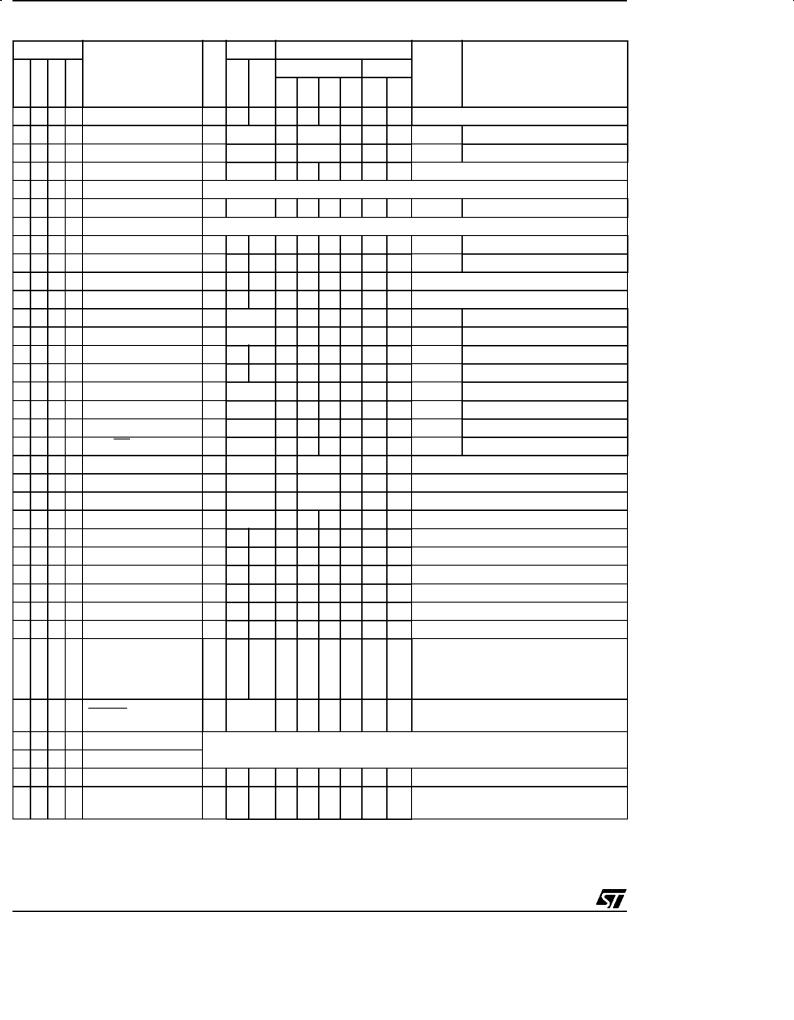
ST72334J/N, ST72314J/N, ST72124J
Pin n°
TQFP64 SDIP56 QFP44 SDIP42 24
25 15 15 10
26 16 16 11
27 17 17 12
28
29 18 18 13
30
31 19 19 14
32 20 20 15
33 21 21
34 22 22
35 23 23 16
36 24 24 17
37 25 25 18
38 26 26 19
39 27 27 20
40 28 28 21
41 29 29 22
42 30 30 23
4331
4432
4533
4634 31 24
4735 32 25
4836 33 26
4937 34 27
5038 35 28
5139 36 29
5240 37 30
|
Type |
Level |
|
Pin Name |
Input |
Output |
|
|
|
|
|
VSS_3 |
S |
|
|
PF0/MCO |
I/O |
CT |
|
PF1/BEEP |
I/O |
CT |
|
PF2 |
I/O |
CT |
|
NC |
|
|
|
PF4/OCMP1_A |
I/O |
CT |
|
NC |
|
|
|
PF6 (HS)/ICAP1_A |
I/O |
CT |
HS |
PF7 (HS)/EXTCLK_A I/O |
CT |
HS |
|
VDD_0 |
S |
|
|
VSS_0 |
S |
|
|
PC0/OCMP2_B |
I/O |
CT |
|
PC1/OCMP1_B |
I/O |
CT |
|
PC2 (HS)/ICAP2_B |
I/O |
CT |
HS |
PC3 (HS)/ICAP1_B |
I/O |
CT |
HS |
PC4/MISO |
I/O |
CT |
|
PC5/MOSI |
I/O |
CT |
|
PC6/SCK |
I/O |
CT |
|
PC7/SS |
I/O |
CT |
|
PA0 |
I/O |
CT |
|
PA1 |
I/O |
CT |
|
PA2 |
I/O |
CT |
|
PA3 |
I/O |
CT |
|
VDD_1 |
S |
|
|
VSS_1 |
S |
|
|
PA4 (HS) |
I/O |
CT |
HS |
PA5 (HS) |
I/O |
CT |
HS |
PA6 (HS) |
I/O |
CT |
HS |
PA7 (HS) |
I/O |
CT |
HS |
|
|
Port |
|
|
Input |
|
|
float |
wpu |
int |
ana |
X |
ei1 |
|
|
X |
ei1 |
|
|
X |
|
ei1 |
|
X |
X |
|
|
X |
X |
|
|
X |
X |
|
|
X |
X |
|
|
X |
X |
|
|
X |
X |
|
|
X |
X |
|
|
X |
X |
|
|
X |
X |
|
|
X |
X |
|
|
X |
X |
|
|
X |
ei0 |
|
|
X |
ei0 |
|
|
X |
ei0 |
|
|
X |
|
ei0 |
|
X |
X |
|
|
X |
X |
|
|
X |
|
|
|
X |
|
|
|
53 41 38 31 |
ISPSEL |
I |
|
|
54 42 39 32 |
RESET |
I/O |
C |
X |
55NC
56NC
57 43 40 33 |
VSS_3 |
S |
58 44 41 34 |
OSC2 3) |
O |
|
|
Main |
|
Output |
function |
Alternate function |
|
|
|
(after |
|
OD |
PP |
|
|
reset) |
|
||
|
|
Digital Ground Voltage |
|
X |
X |
Port F0 |
Main clock output (fOSC/2) |
X |
X |
Port F1 |
Beep signal output |
X |
X |
Port F2 |
|
Not Connected |
|
||
X |
X |
Port F4 |
Timer A Output Compare 1 |
Not Connected |
|
||
X |
X |
Port F6 |
Timer A Input Capture 1 |
X |
X |
Port F7 |
Timer A External Clock Source |
|
|
Digital Main Supply Voltage |
|
|
|
Digital Ground Voltage |
|
X |
X |
Port C0 |
Timer B Output Compare 2 |
X |
X |
Port C1 |
Timer B Output Compare 1 |
X |
X |
Port C2 |
Timer B Input Capture 2 |
X |
X |
Port C3 |
Timer B Input Capture 1 |
X |
X |
Port C4 |
SPI Master In / Slave Out Data |
X |
X |
Port C5 |
SPI Master Out / Slave In Data |
X |
X |
Port C6 |
SPI Serial Clock |
X |
X |
Port C7 |
SPI Slave Select (active low) |
X |
X |
Port A0 |
|
X |
X |
Port A1 |
|
X |
X |
Port A2 |
|
X |
X |
Port A3 |
|
|
|
Digital Main Supply Voltage |
|
|
|
Digital Ground Voltage |
|
X |
X |
Port A4 |
|
X |
X |
Port A5 |
|
T |
|
Port A6 |
|
TPort A7
Must be tied low in user mode. In programming mode when available, this pin acts as In-Situ Programming mode selection.
X
Top priority non maskable interrupt (active low)
Not Connected
Digital Ground Voltage
Resonator oscillator inverter output or capacitor input for RC oscillator
10/148
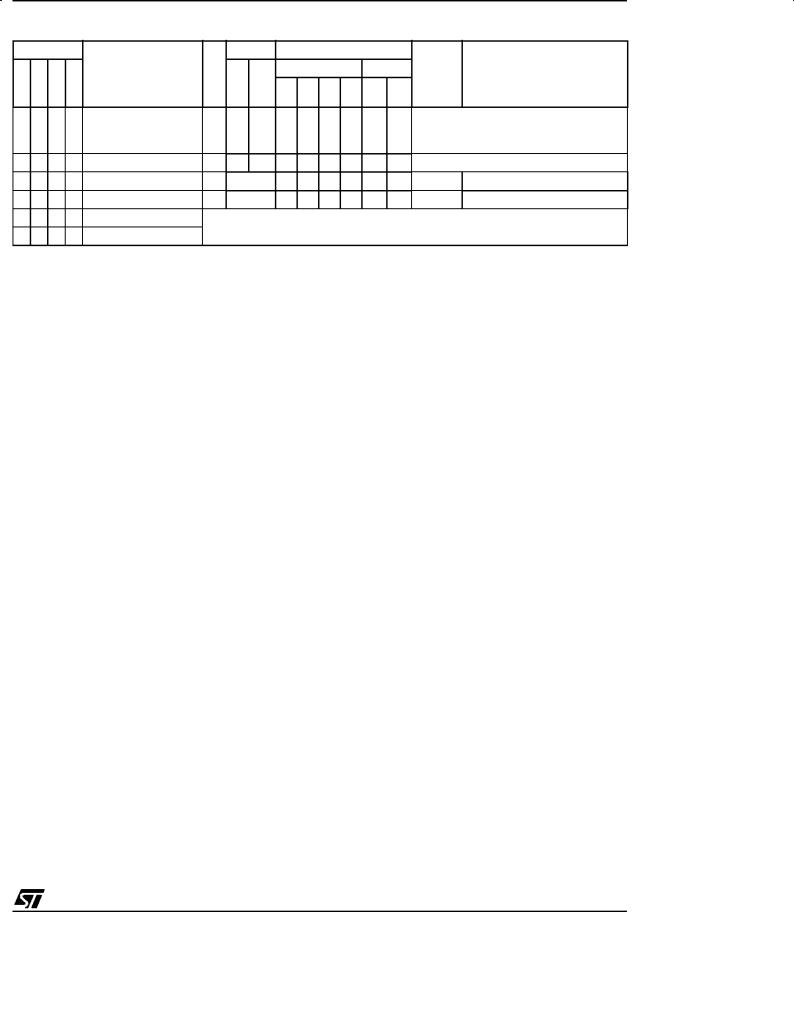
ST72334J/N, ST72314J/N, ST72124J
Pin n° |
|
TQFP64 SDIP56 QFP44 SDIP42 |
Pin Name |
|
|
59 45 42 35 |
OSC1 3) |
60 46 43 36 |
VDD_3 |
61 47 44 37 |
PE0/TDO |
62 48 1 38 |
PE1/RDI |
63NC
64NC
|
Level |
|
Type |
Input |
Output |
I
S
I/O CT I/O CT
|
|
Port |
|
|
Input |
|
|
float |
wpu |
int |
ana |
X X
X X
|
|
Main |
|
Output |
function |
Alternate function |
|
|
|
(after |
|
OD |
PP |
|
|
reset) |
|
||
External clock input or Resonator oscillator inverter input or resistor input for RC oscillator
Digital Main Supply Voltage
X |
X |
Port E0 |
SCI Transmit Data Out |
X |
X |
Port E1 |
SCI Receive Data In |
Not Connected
Notes:
1. In the interrupt input column, ªeiº defines the associated external interrupt vector. If the weak pull-up
x
column (wpu) is merged with the interrupt column (int), then the I/O configuration is pull-up interrupt input, else the configuration is floating interrupt input.
2. In the open drain output column, ªTº defines a true open drain I/O (P-Buffer and protection diode to V
DD
are not implemented). See Section 11 ºI/O PORTSº on page 37 and Section 15.8 ºI/O PORT PIN CHARACTERISTICSº on page 125 for more details.
3. OSC1 and OSC2 pins connect a crystal or ceramic resonator, an external RC, or an external source to the on-chip oscillator see Section 3 ºPIN DESCRIPTIONº on page 6 and Section 15.5 ºCLOCK AND TIMING CHARACTERISTICSº on page 113 for more details.
11/148
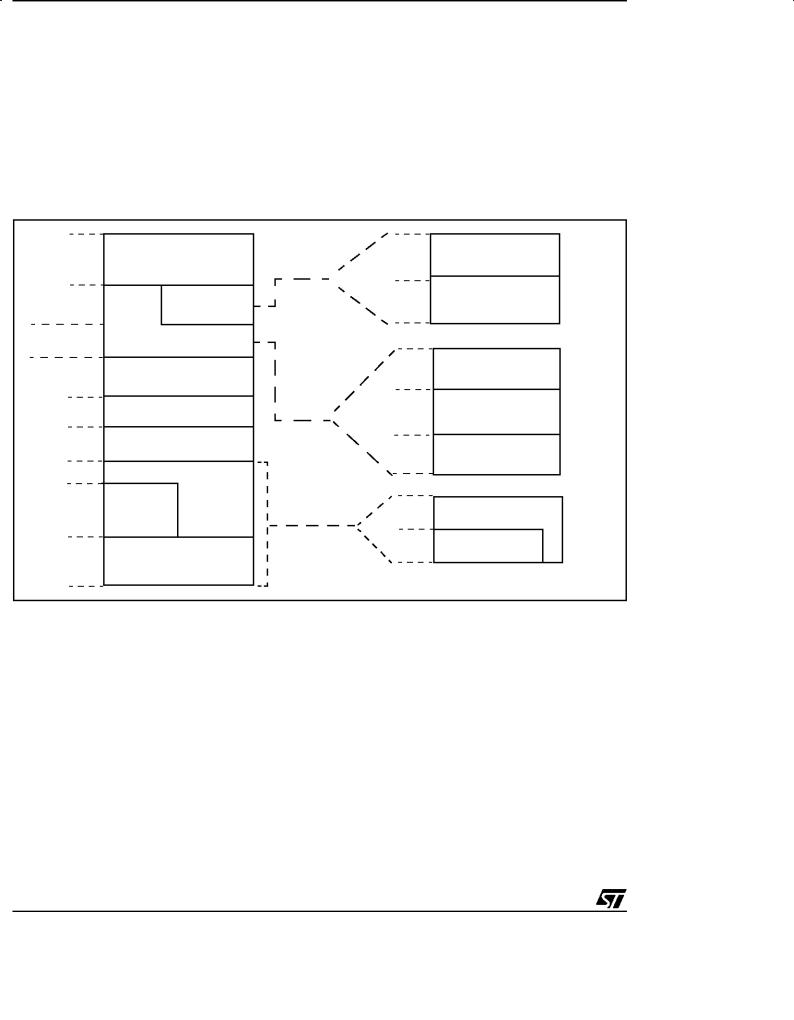
ST72334J/N, ST72314J/N, ST72124J
4 REGISTER & MEMORY MAP
As shown in the Figure 5, the MCU is capable of addressing 64K bytes of memories and I/O registers.
The available memory locations consist of 128 bytes of register locations, 384 or 512 bytes of RAM, up to 256 bytes of data EEPROM and 4 or 8 Kbytes of user program memory. The RAM
Figure 5. Memory Map
0000h
HW Registers
(see Table 2)
007Fh
0080h
384 Bytes RAM
01FFh
512 Bytes RAM
027Fh
0200h / 0280h
Reserved
0BFFh
0C00h
256 Bytes Data EEPROM
0CFFh
0D00h
Reserved
BFFFh
C000h
16K Bytes
E000h 8K Bytes Program
Program Memory
FFDFh Memory
FFE0h
Interrupt & Reset Vectors
(see Table 6 on page 32)
FFFFh
space includes up to 256 bytes for the stack from 0100h to 01FFh.
The highest address bytes contain the user reset and interrupt vectors.
IMPORTANT: Memory locations marked as ªReservedº must never be accessed. Accessing a reseved area can have unpredicable effects on the device.
0080h |
Short Addressing RAM |
|
|
Zero page |
|
00FFh |
(128 Bytes) |
|
Stack or |
||
0100h |
||
|
16-bit Addressing RAM |
|
01FFh |
(256 Bytes) |
|
|
||
0080h |
Short Addressing RAM |
|
00FFh |
Zero page |
|
(128 Bytes) |
||
|
||
0100h |
Stack or |
|
|
||
|
16-bit Addressing RAM |
|
01FFh |
(256 Bytes) |
|
0200h |
16-bit Addressing |
|
027Fh |
RAM |
|
|
C000h
16 KBytes
E000h
8 KBytes
FFFFh
12/148
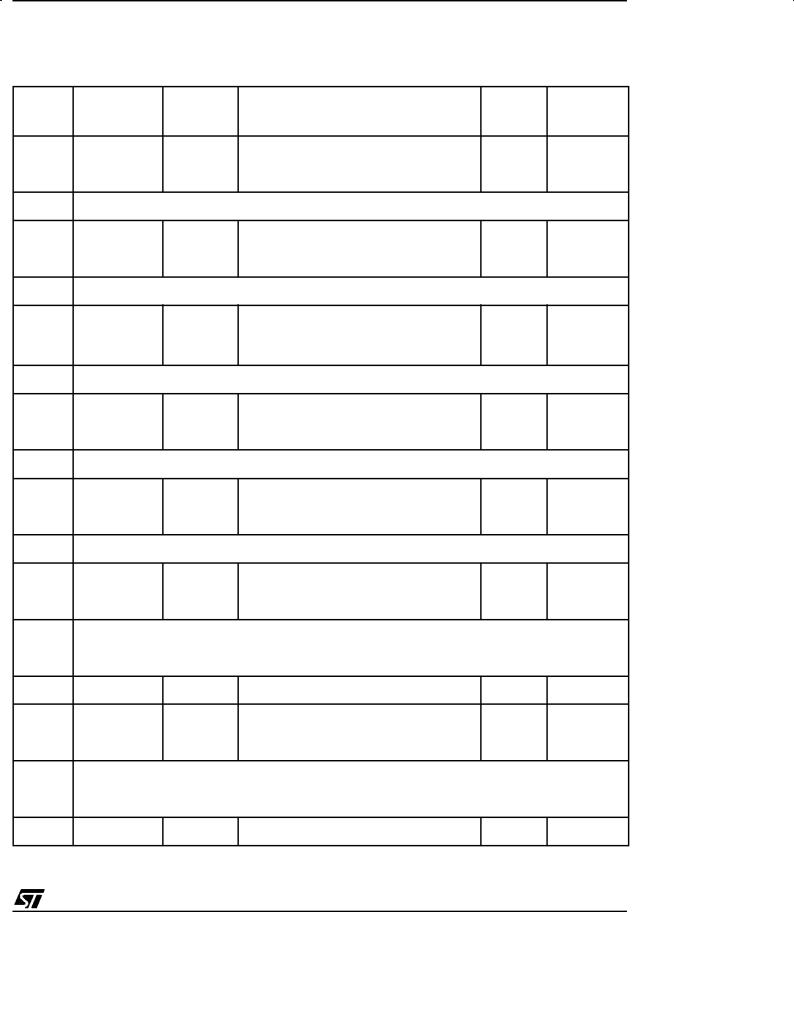
ST72334J/N, ST72314J/N, ST72124J
REGISTER & MEMORY MAP (Cont'd)
Table 2. Hardware Register Map
Address |
Block |
Register |
Register Name |
Reset |
Remarks |
|
Label |
Status |
|||||
|
|
|
|
|||
0000h |
|
PADR |
Port A Data Register |
00h1) |
R/W |
|
0001h |
Port A |
PADDR |
Port A Data Direction Register |
00h |
R/W |
|
0002h |
|
PAOR |
Port A Option Register |
00h |
R/W 2) |
|
0003h |
|
|
Reserved Area (1 Byte) |
|
|
|
0004h |
|
PCDR |
Port C Data Register |
00h1) |
R/W |
|
0005h |
Port C |
PCDDR |
Port C Data Direction Register |
00h |
R/W |
|
0006h |
|
PCOR |
Port C Option Register |
00h |
R/W |
|
0007h |
|
|
Reserved Area (1 Byte) |
|
|
|
0008h |
|
PBDR |
Port B Data Register |
00h1) |
R/W |
|
0009h |
Port B |
PBDDR |
Port B Data Direction Register |
00h |
R/W |
|
000Ah |
|
PBOR |
Port B Option Register |
00h |
R/W 2) |
|
000Bh |
|
|
Reserved Area (1 Byte) |
|
|
|
000Ch |
|
PEDR |
Port E Data Register |
00h1) |
R/W |
|
000Dh |
Port E |
PEDDR |
Port E Data Direction Register |
00h |
R/W |
|
000Eh |
|
PEOR |
Port E Option Register |
00h |
R/W 2) |
|
000Fh |
|
|
Reserved Area (1 Byte) |
|
|
|
0010h |
|
PDDR |
Port D Data Register |
00h1) |
R/W |
|
0011h |
Port D |
PDDDR |
Port D Data Direction Register |
00h |
R/W |
|
0012h |
|
PDOR |
Port D Option Register |
00h |
R/W 2) |
|
0013h |
|
|
Reserved Area (1 Byte) |
|
|
|
0014h |
|
PFDR |
Port F Data Register |
00h1) |
R/W |
|
0015h |
Port F |
PFDDR |
Port F Data Direction Register |
00h |
R/W |
|
0016h |
|
PFOR |
Port F Option Register |
00h |
R/W |
|
0017h |
|
|
|
|
|
|
to |
|
|
Reserved Area (9 Bytes) |
|
|
|
001Fh |
|
|
|
|
|
|
0020h |
|
MISCR1 |
Miscellaneous Register 1 |
00h |
R/W |
|
0021h |
|
SPIDR |
SPI Data I/O Register |
xxh |
R/W |
|
0022h |
SPI |
SPICR |
SPI Control Register |
0xh |
R/W |
|
0023h |
|
SPISR |
SPI Status Register |
00h |
Read Only |
|
0024h |
|
|
|
|
|
|
to |
|
|
Reserved Area (5 Bytes) |
|
|
|
0028h |
|
|
|
|
|
|
0029h |
MCC |
MCCSR |
Main Clock Control / Status Register |
01h |
R/W |
13/148
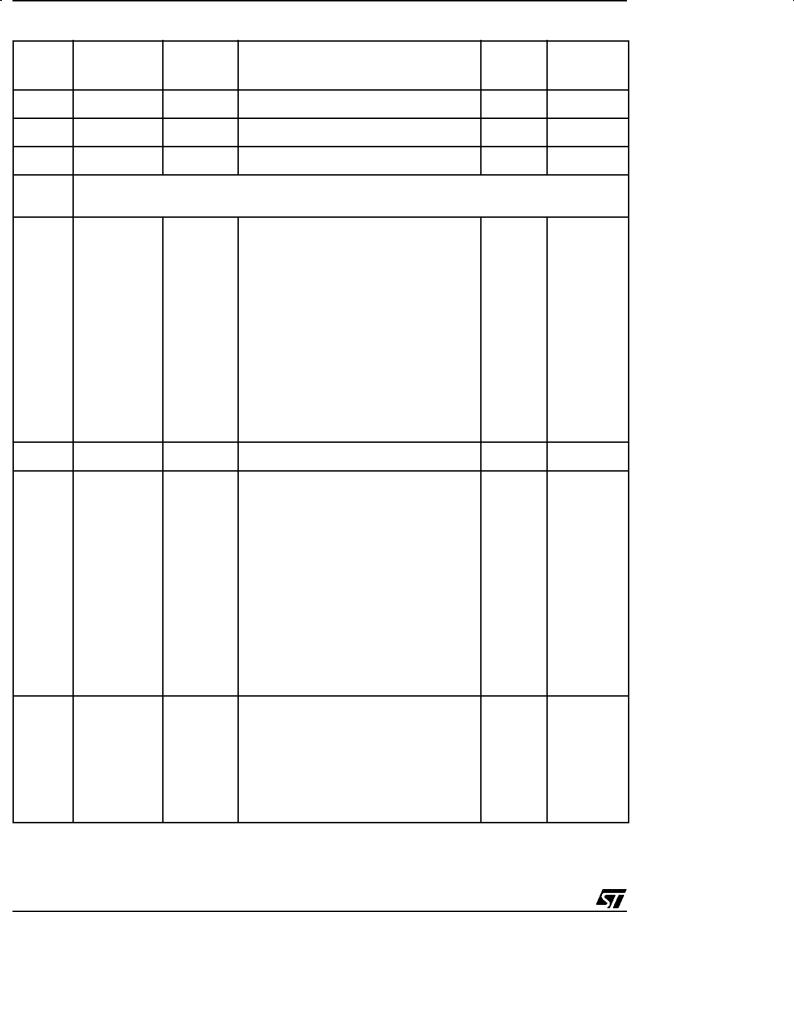
ST72334J/N, ST72314J/N, ST72124J
Address |
Block |
Register |
Register Name |
Reset |
Remarks |
|
Label |
Status |
|||||
|
|
|
|
|||
002Ah |
WATCHDOG |
WDGCR |
Watchdog Control Register |
7Fh |
R/W |
|
002Bh |
|
CRSR |
Clock, Reset, Supply Control / Status Register |
000x 000x |
R/W |
|
002Ch |
Data-EEPROM |
EECSR |
Data-EEPROM Control/Status Register |
00h |
R/W |
|
002Dh |
|
|
Reserved Area (4 Bytes) |
|
|
|
0030h |
|
|
|
|
||
|
|
|
|
|
0031h
0032h
0033h
0034h
0035h
0036h
0037h
0038h
0039h
003Ah
003Bh
003Ch
003Dh
003Eh
003Fh
0040h
0041h
0042h
0043h
0044h
0045h
0046h
0047h
0048h
0049h
004Ah
004Bh
004Ch
004Dh
004Eh
004Fh
0050h
0051h
0052h
0053h
0054h
0055h
0056h
0057h
TIMER A
TIMER B
SCI
TACR2 |
Timer A Control Register 2 |
00h |
R/W |
TACR1 |
Timer A Control Register 1 |
00h |
R/W |
TASR |
Timer A Status Register |
xxh |
Read Only |
TAIC1HR |
Timer A Input Capture 1 High Register |
xxh |
Read Only |
TAIC1LR |
Timer A Input Capture 1 Low Register |
xxh |
Read Only |
TAOC1HR |
Timer A Output Compare 1 High Register |
80h |
R/W |
TAOC1LR |
Timer A Output Compare 1 Low Register |
00h |
R/W |
TACHR |
Timer A Counter High Register |
FFh |
Read Only |
TACLR |
Timer A Counter Low Register |
FCh |
Read Only |
TAACHR |
Timer A Alternate Counter High Register |
FFh |
Read Only |
TAACLR |
Timer A Alternate Counter Low Register |
FCh |
Read Only |
TAIC2HR |
Timer A Input Capture 2 High Register |
xxh |
Read Only 3) |
TAIC2LR |
Timer A Input Capture 2 Low Register |
xxh |
Read Only 3) |
TAOC2HR |
Timer A Output Compare 2 High Register |
80h |
R/W 3) |
TAOC2LR |
Timer A Output Compare 2 Low Register |
00h |
R/W 3) |
MISCR2 |
Miscellaneous Register 2 |
00h |
R/W |
TBCR2 |
Timer B Control Register 2 |
00h |
R/W |
TBCR1 |
Timer B Control Register 1 |
00h |
R/W |
TBSR |
Timer B Status Register |
xxh |
Read Only |
TBIC1HR |
Timer B Input Capture 1 High Register |
xxh |
Read Only |
TBIC1LR |
Timer B Input Capture 1 Low Register |
xxh |
Read Only |
TBOC1HR |
Timer B Output Compare 1 High Register |
80h |
R/W |
TBOC1LR |
Timer B Output Compare 1 Low Register |
00h |
R/W |
TBCHR |
Timer B Counter High Register |
FFh |
Read Only |
TBCLR |
Timer B Counter Low Register |
FCh |
Read Only |
TBACHR |
Timer B Alternate Counter High Register |
FFh |
Read Only |
TBACLR |
Timer B Alternate Counter Low Register |
FCh |
Read Only |
TBIC2HR |
Timer B Input Capture 2 High Register |
xxh |
Read Only |
TBIC2LR |
Timer B Input Capture 2 Low Register |
xxh |
Read Only |
TBOC2HR |
Timer B Output Compare 2 High Register |
80h |
R/W |
TBOC2LR |
Timer B Output Compare 2 Low Register |
00h |
R/W |
SCISR |
SCI Status Register |
C0h |
Read Only |
SCIDR |
SCI Data Register |
xxh |
R/W |
SCIBRR |
SCI Baud Rate Register |
00xx xxxx |
R/W |
SCICR1 |
SCI Control Register 1 |
xxh |
R/W |
SCICR2 |
SCI Control Register 2 |
00h |
R/W |
SCIERPR |
SCI Extended Receive Prescaler Register |
00h |
R/W |
|
Reserved area |
--- |
|
SCIETPR |
SCI Extended Transmit Prescaler Register |
00h |
R/W |
14/148
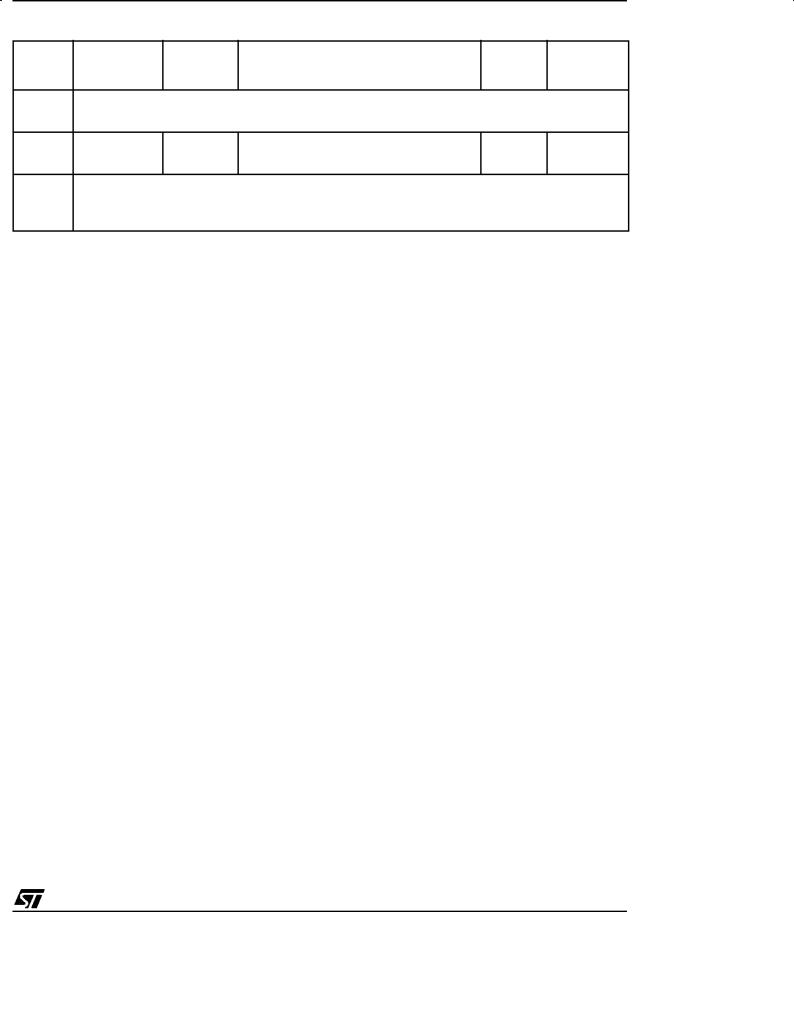
ST72334J/N, ST72314J/N, ST72124J
Address |
Block |
Register |
Register Name |
Reset |
Remarks |
|
Label |
Status |
|||||
|
|
|
|
|||
0058h |
|
|
Reserved Area (24 Bytes) |
|
|
|
006Fh |
|
|
|
|
||
|
|
|
|
|
||
0070h |
ADC |
ADCDR |
Data Register |
xxh |
Read Only |
|
0071h |
ADCCSR |
Control/Status Register |
00h |
R/W |
||
|
||||||
0072h |
|
|
|
|
|
|
to |
|
|
Reserved Area (14 Bytes) |
|
|
|
007Fh |
|
|
|
|
|
Legend: x=undefined, R/W=read/write
Notes:
1.The contents of the I/O port DR registers are readable only in output configuration. In input configuration, the values of the I/O pins are returned instead of the DR register contents.
2.The bits corresponding to unavailable pins are forced to 1 by hardware, affecting accordingly the reset status value. These bits must always keep their reset value.
3.External pin not available.
15/148
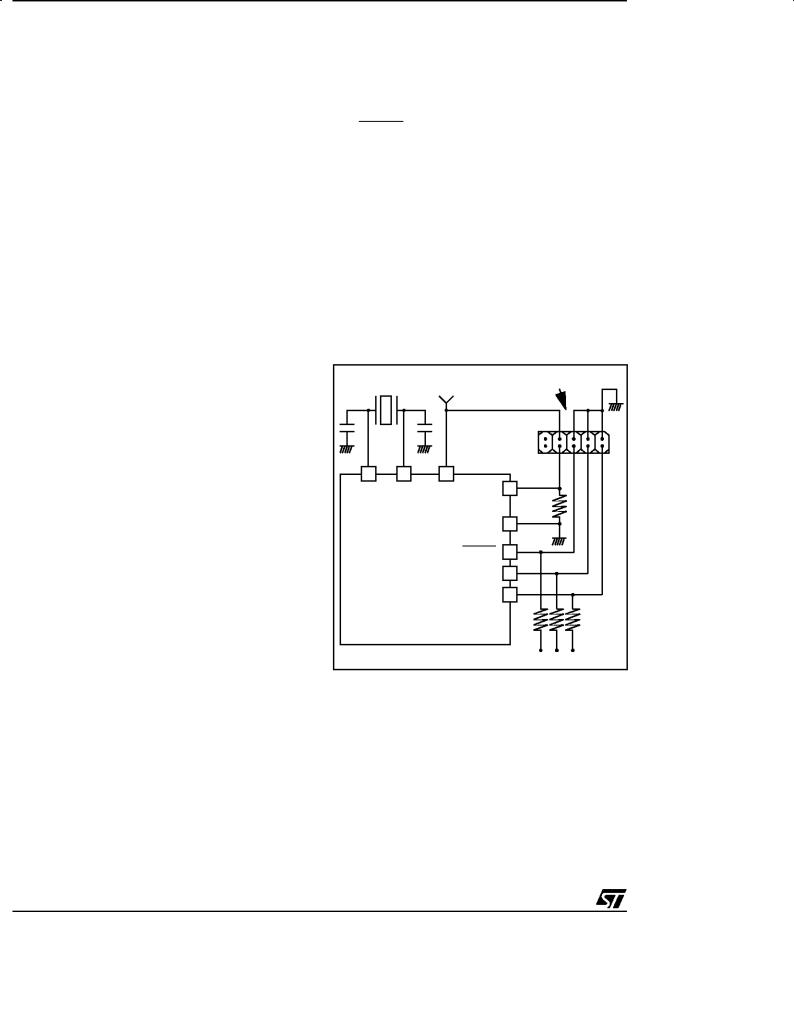
ST72334J/N, ST72314J/N, ST72124J
5 FLASH PROGRAM MEMORY
5.1 INTRODUCTION
FLASH devices have a single voltage non-volatile FLASH memory that may be programmed in-situ (or plugged in a programming tool) on a byte-by- byte basis.
5.2 MAIN FEATURES
■Remote In-Situ Programming (ISP) mode
■Up to 16 bytes programmed in the same cycle
■MTP memory (Multiple Time Programmable)
■Read-out memory protection against piracy
5.3 STRUCTURAL ORGANISATION
The FLASH program memory is organised in a single 8-bit wide memory block which can be used for storing both code and data constants.
The FLASH program memory is mapped in the upper part of the ST7 addressing space and includes the reset and interrupt user vector area .
5.4 IN-SITU PROGRAMMING (ISP) MODE
The FLASH program memory can be programmed using Remote ISP mode. This ISP mode allows the contents of the ST7 program memory to be updated using a standard ST7 programming tools after the device is mounted on the application board. This feature can be implemented with a minimum number of added components and board area impact.
An example Remote ISP hardware interface to the standard ST7 programming tool is described below. For more details on ISP programming, refer to the ST7 Programming Specification.
Remote ISP Overview
The Remote ISP mode is initiated by a specific sequence on the dedicated ISPSEL pin.
The Remote ISP is performed in three steps:
±Selection of the RAM execution mode
±Download of Remote ISP code in RAM
±Execution of Remote ISP code in RAM to program the user program into the FLASH
Remote ISP hardware configuration
In Remote ISP mode, the ST7 has to be supplied with power (VDD and VSS) and a clock signal (oscillator and application crystal circuit for example).
This mode needs five signals (plus the VDD signal if necessary) to be connected to the programming tool. This signals are:
±RESET: device reset
±VSS: device ground power supply
±ISPCLK: ISP output serial clock pin
±ISPDATA: ISP input serial data pin
±ISPSEL: Remote ISP mode selection. This pin
must be connected to VSS on the application board through a pull-down resistor.
If any of these pins are used for other purposes on the application, a serial resistor has to be implemented to avoid a conflict if the other device forces the signal level.
Figure 6 shows a typical hardware interface to a standard ST7 programming tool. For more details on the pin locations, refer to the device pinout description.
Figure 6. Typical Remote ISP Interface
|
|
|
HE10 CONNECTOR TYPE |
XTAL |
|
TO PROGRAMMING TOOL |
|
CL0 |
|
CL1 |
1 |
|
|
||
OSC2 |
OSC1 |
DD |
ISPSEL |
|
|||
V |
|
||
10KΩ
|
VSS |
|
RESET |
ST7 |
ISPCLK |
|
ISPDATA
47KΩ
APPLICATION
5.5 MEMORY READ-OUT PROTECTION
The read-out protection is enabled through an option bit.
For FLASH devices, when this option is selected, the program and data stored in the FLASH memory are protected against read-out piracy (including a re-write protection). When this protection option is removed the entire FLASH program memory is first automatically erased. However, the E2PROM data memory (when available) can be protected only with ROM devices.
16/148
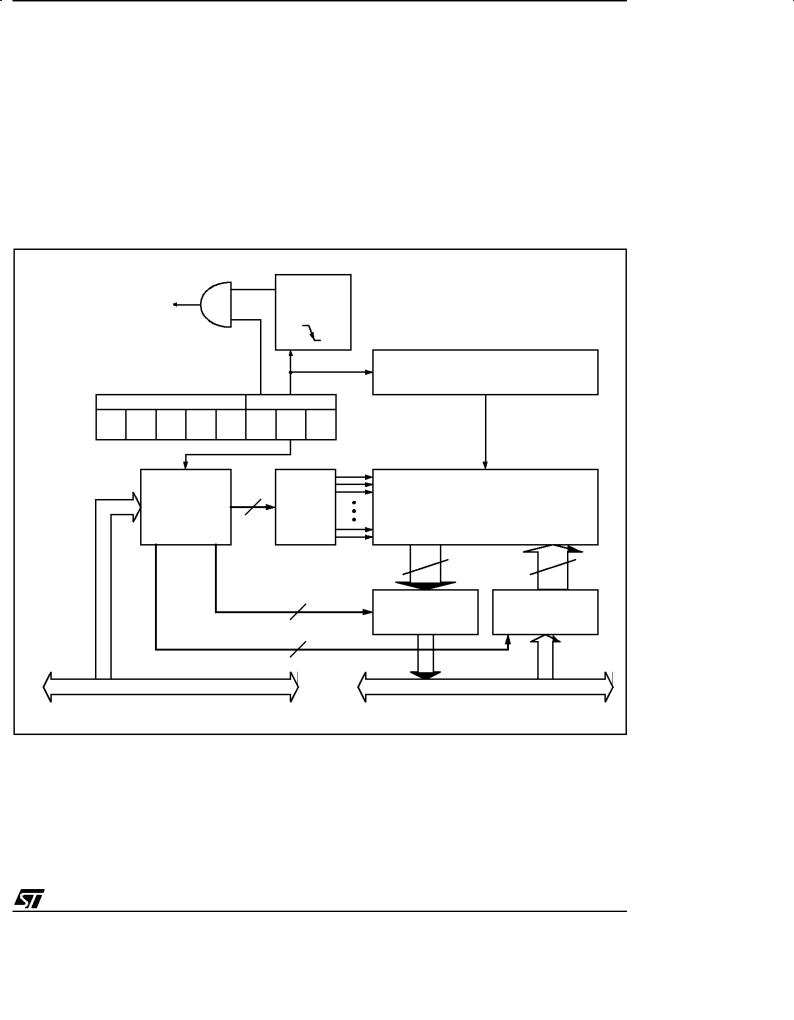
6 DATA EEPROM
6.1 INTRODUCTION
The Electrically Erasable Programmable Read Only Memory can be used as a non volatile backup for storing data. Using the EEPROM requires a basic access protocol described in this chapter.
Figure 7. EEPROM Block Diagram
ST72334J/N, ST72314J/N, ST72124J
6.2 MAIN FEATURES
■Up to 16 Bytes programmed in the same cycle
■EEPROM mono-voltage (charge pump)
■Chained erase and programming cycles
■Internal control of the global programming cycle duration
■End of programming cycle interrupt flag
■WAIT mode management
FALLING
EEPROM INTERRUPT EDGE
DETECTOR
|
|
|
|
|
HIGH VOLTAGE |
|
|
|
|
|
|
|
PUMP |
EECSR |
RESERVED |
|
EEPROM |
|
||
0 0 |
0 0 |
IE |
LAT |
PGM |
|
|
0 |
|
|||||
|
ADDRESS |
4 |
|
EEPROM |
||
|
ROW |
|
||||
|
DECODER |
|
|
MEMORY MATRIX |
||
|
|
DECODER |
|
|||
|
|
|
|
|
(1 ROW = 16 x 8 BITS) |
|
|
|
|
|
|
128 |
128 |
|
|
|
|
4 |
DATA |
16 x 8 BITS |
|
|
|
|
|
MULTIPLEXER |
DATA LATCHES |
|
|
|
|
4 |
|
|
|
ADDRESS BUS |
|
|
DATA BUS |
||
17/148
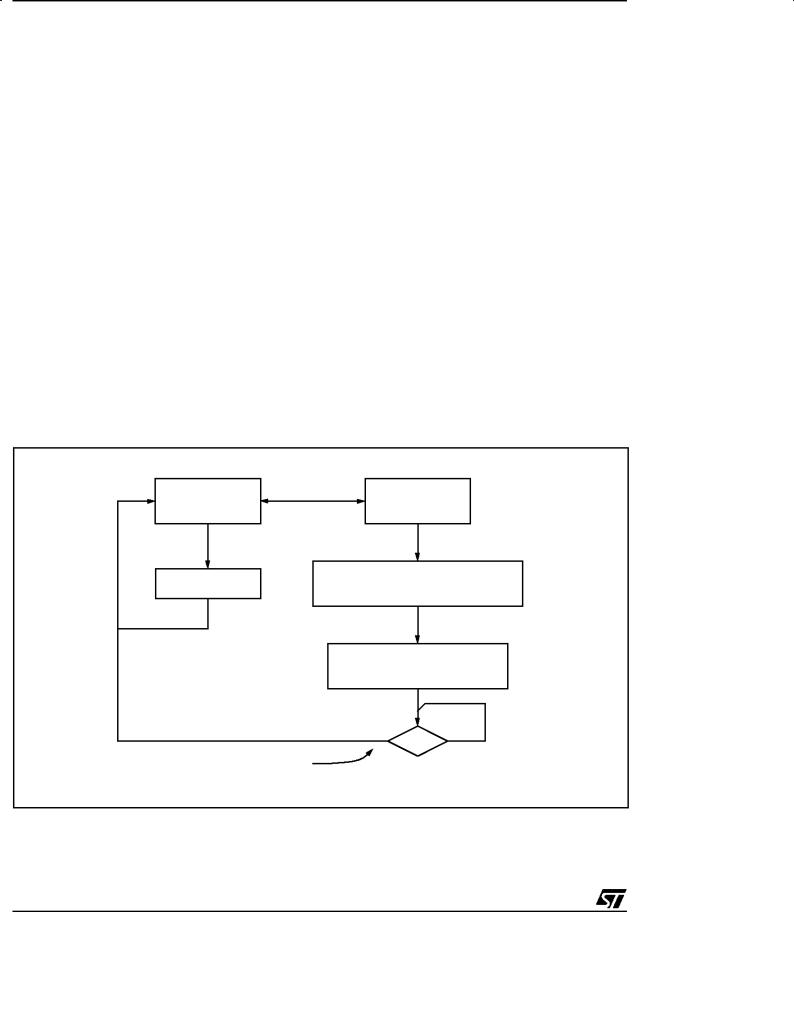
ST72334J/N, ST72314J/N, ST72124J
DATA EEPROM (Cont'd)
6.3 MEMORY ACCESS
The Data EEPROM memory read/write access modes are controlled by the LAT bit of the EEPROM Control/Status register (EECSR). The flowchart in Figure 8 describes these different memory access modes.
Read Operation (LAT=0)
The EEPROM can be read as a normal ROM location when the LAT bit of the EECSR register is cleared. In a read cycle, the byte to be accessed is put on the data bus in less than 1 CPU clock cycle. This means that reading data from EEPROM takes the same time as reading data from EPROM, but this memory cannot be used to execute machine code.
Write Operation (LAT=1)
To access the write mode, the LAT bit has to be set by software (the PGM bit remains cleared). When a write access to the EEPROM area occurs, the value is latched inside the 16 data latches according to its address.
Figure 8. Data EEPROM Programming Flowchart
When PGM bit is set by the software, all the previous bytes written in the data latches (up to 16) are programmed in the EEPROM cells. The effective high address (row) is determined by the last EEPROM write sequence. To avoid wrong programming, the user must take care that all the bytes written between two programming sequences have the same high address: only the four Least Significant Bits of the address can change.
At the end of the programming cycle, the PGM and LAT bits are cleared simultaneously, and an interrupt is generated if the IE bit is set. The Data EEPROM interrupt request is cleared by hardware when the Data EEPROM interrupt vector is fetched.
Note: Care should be taken during the programming cycle. Writing to the same memory location will over-program the memory (logical AND between the two write access data result) because the data latches are only cleared at the end of the programming cycle and by the falling edge of LAT bit.
It is not possible to read the latched data. This note is ilustrated by the Figure 9.
READ MODE |
|
WRITE MODE |
|
LAT=0 |
|
LAT=1 |
|
PGM=0 |
|
PGM=0 |
|
READ BYTES |
WRITE UP TO 16 BYTES |
||
IN EEPROM AREA |
|||
IN EEPROM AREA |
|||
(with the same 12 MSB of the address) |
|||
|
|||
|
START PROGRAMMING CYCLE |
||
|
|
LAT=1 |
|
|
PGM=1 (set by software) |
||
INTERRUPT GENERATION |
|
|
|
IF IE=1 |
0 |
1 |
|
|
|
LAT |
|
CLEARED BY HARDWARE
18/148
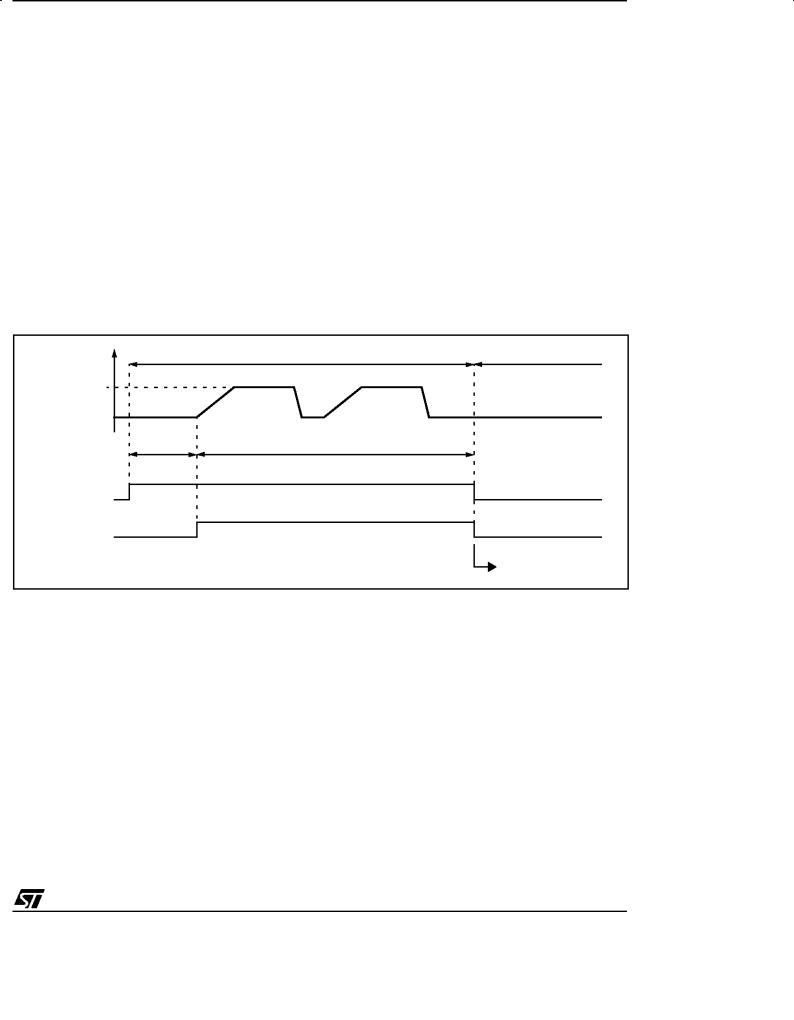
ST72334J/N, ST72314J/N, ST72124J
DATA EEPROM (Cont'd)
6.4 POWER SAVING MODES Wait mode
The DATA EEPROM can enter WAIT mode on execution of the WFI instruction of the microcontroller. The DATA EEPROM will immediately enter this mode if there is no programming in progress, otherwise the DATA EEPROM will finish the cycle and then enter WAIT mode.
Halt mode
The DATA EEPROM immediatly enters HALT mode if the microcontroller executes the HALT instruction. Therefore the EEPROM will stop the function in progress, and data may be corrupted.
6.5 ACCESS ERROR HANDLING
If a read access occurs while LAT=1, then the data bus will not be driven.
If a write access occurs while LAT=0, then the data on the bus will not be latched.
If a programming cycle is interrupted (by software/ RESET action), the memory data will not be guaranteed.
Figure 9. Data EEPROM Programming Cycle
READ OPERATION NOT POSSIBLE |
READ OPERATION POSSIBLE |
|
INTERNAL |
|
|
PROGRAMMING |
|
|
VOLTAGE |
|
|
ERASE CYCLE |
WRITE CYCLE |
|
WRITE OF
DATA LATCHES
tPROG
LAT
PGM
EEPROM INTERRUPT
19/148
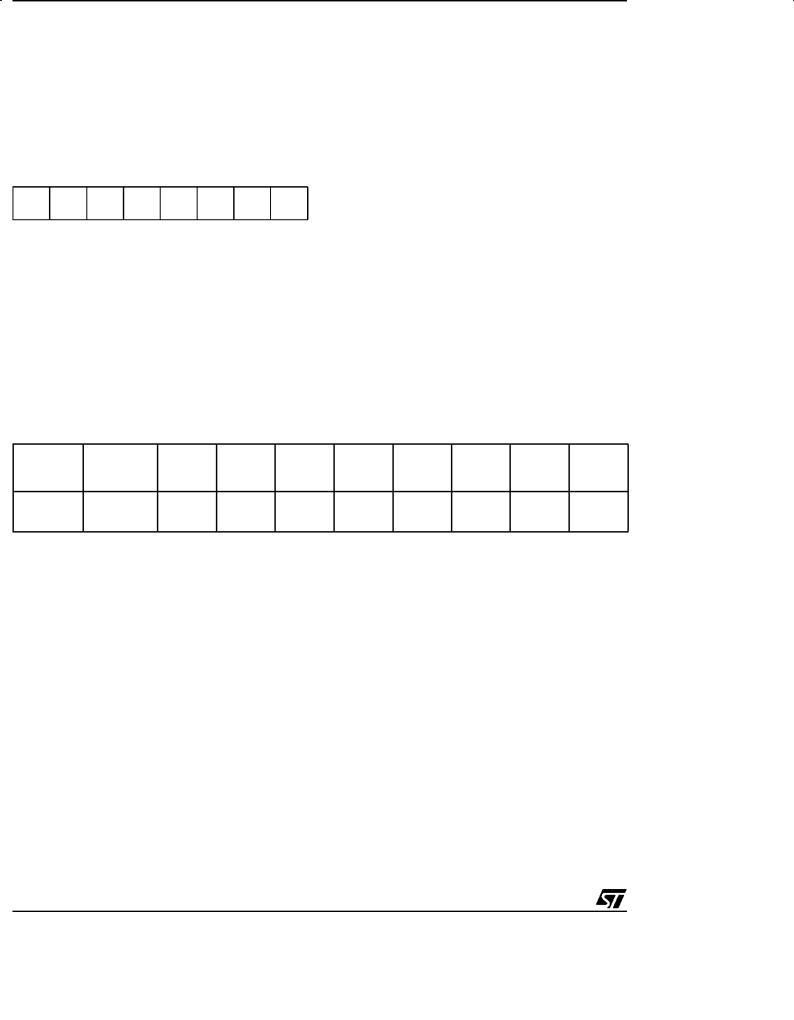
ST72334J/N, ST72314J/N, ST72124J
DATA EEPROM (Cont'd)
6.6 REGISTER DESCRIPTION CONTROL/STATUS REGISTER (CSR)
Read/Write
Reset Value: 0000 0000 (00h)
7 |
0 |
Bit 1 = LAT Latch Access Transfer
This bit is set by software. It is cleared by hardware at the end of the programming cycle. It can only be cleared by software if PGM bit is cleared.
0:Read mode
1:Write mode
0 |
0 |
0 |
0 |
0 |
IE LAT PGM |
Bit 7:3 = Reserved, forced by hardware to 0.
Bit 2 = IE Interrupt enable
This bit is set and cleared by software. It enables the Data EEPROM interrupt capability when the PGM bit is cleared by hardware. The interrupt request is automatically cleared when the software enters the interrupt routine.
0:Interrupt disabled
1:Interrupt enabled
Bit 0 = PGM Programming control and status
This bit is set by software to begin the programming cycle. At the end of the programming cycle, this bit is clearedby hardware and an interrupt is generated if the ITE bit is set.
0:Programming finished or not yet started
1:Programming cycle is in progress
Note: if the PGM bit is cleared during the programming cycle, the memory data is not guaranteed
Table 3. DATA EEPROM Register Map and Reset Values
Address |
Register |
7 |
6 |
5 |
4 |
3 |
2 |
1 |
0 |
|
(Hex.) |
Label |
|||||||||
|
|
|
|
|
|
|
|
|||
002Ch |
EECSR |
|
|
|
|
|
IE |
RWM |
PGM |
|
Reset Value |
0 |
0 |
0 |
0 |
0 |
0 |
0 |
0 |
||
|
6.7 READ-OUT PROTECTION OPTION
The Data EEPROM can be optionally read-out protected in ST72334 ROM devices (see option
list on page 145). ST72C334 Flash devices do not have this protection option.
20/148
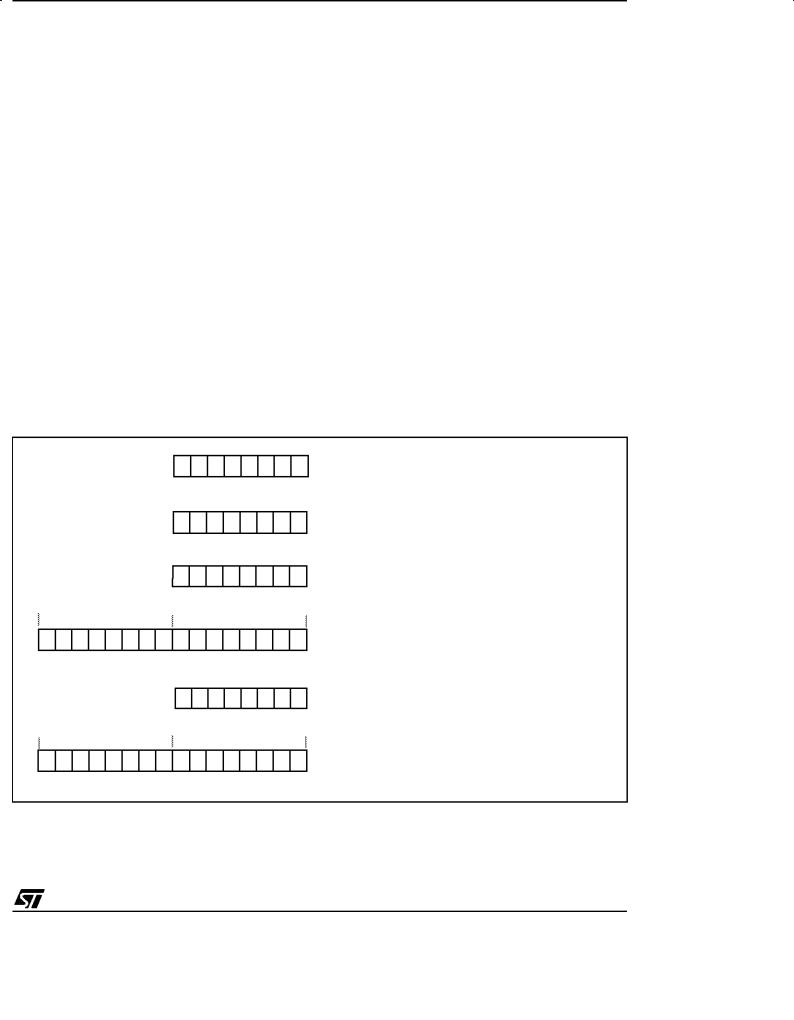
ST72334J/N, ST72314J/N, ST72124J
7 CENTRAL PROCESSING UNIT
7.1 INTRODUCTION
This CPU has a full 8-bit architecture and contains six internal registers allowing efficient 8-bit data manipulation.
7.2 MAIN FEATURES
■63 basic instructions
■Fast 8-bit by 8-bit multiply
■17 main addressing modes
■Two 8-bit index registers
■16-bit stack pointer
■Low power modes
■Maskable hardware interrupts
■Non-maskable software interrupt
7.3 CPU REGISTERS
The 6 CPU registers shown in Figure 10 are not present in the memory mapping and are accessed by specific instructions.
Figure 10. CPU Registers
|
|
|
7 |
|
|
|
|
|
|
0 |
|
|
|
RESET VALUE = XXh |
|
||||||
|
|
|
7 |
|
|
|
|
|
|
0 |
|
|
|
RESET VALUE = XXh |
|
||||||
|
|
|
7 |
|
|
|
|
|
|
0 |
|
|
|
RESET VALUE = XXh |
|
||||||
15 |
PCH |
8 |
7 |
|
|
PCL |
|
|
0 |
|
RESET VALUE = RESET VECTOR @ FFFEh-FFFFh |
||||||||||
|
|
|
7 |
|
|
|
|
|
|
0 |
|
|
|
1 |
1 |
1 |
H |
I |
N |
Z |
C |
|
RESET VALUE = 1 |
1 |
1 |
X |
1 |
X |
X |
X |
||
15 |
|
8 |
7 |
|
|
|
|
|
|
0 |
RESET VALUE = STACK HIGHER ADDRESS
Accumulator (A)
The Accumulator is an 8-bit general purpose register used to hold operands and the results of the arithmetic and logic calculations and to manipulate data.
Index Registers (X and Y)
In indexed addressing modes, these 8-bit registers are used to create either effective addresses or temporary storage areas for data manipulation. (The Cross-Assembler generates a precede instruction (PRE) to indicate that the following instruction refers to the Y register.)
The Y register is not affected by the interrupt automatic procedures (not pushed to and popped from the stack).
Program Counter (PC)
The program counter is a 16-bit register containing the address of the next instruction to be executed by the CPU. It is made of two 8-bit registers PCL (Program Counter Low which is the LSB) and PCH (Program Counter High which is the MSB).
ACCUMULATOR
XINDEX REGISTER
YINDEX REGISTER
PROGRAM COUNTER
CONDITION CODE REGISTER
STACK POINTER
X = Undefined Value
21/148

ST72334J/N, ST72314J/N, ST72124J
CPU REGISTERS (Cont'd)
CONDITION CODE REGISTER (CC)
Read/Write
Reset Value: 111x1xxx
7 |
|
|
|
|
|
|
0 |
1 |
1 |
1 |
H |
I |
N |
Z |
C |
The 8-bit Condition Code register contains the interrupt mask and four flags representative of the result of the instruction just executed. This register can also be handled by the PUSH and POP instructions.
These bits can be individually tested and/or controlled by specific instructions.
Bit 4 = H Half carry.
This bit is set by hardware when a carry occurs between bits 3 and 4 of the ALU during an ADD or ADC instruction. It is reset by hardware during the same instructions.
0:No half carry has occurred.
1:A half carry has occurred.
This bit is tested using the JRH or JRNH instruction. The H bit is useful in BCD arithmetic subroutines.
Bit 3 = I Interrupt mask.
This bit is set by hardware when entering in interrupt or by software to disable all interrupts except the TRAP software interrupt. This bit is cleared by software.
0:Interrupts are enabled.
1:Interrupts are disabled.
This bit is controlled by the RIM, SIM and IRET instructions and is tested by the JRM and JRNM instructions.
Note: Interrupts requested while I is set are latched and can be processed when I is cleared. By default an interrupt routine is not interruptable because the I bit is set by hardware when you enter it and reset by the IRET instruction at the end of the interrupt routine. If the I bit is cleared by software in the interrupt routine, pending interrupts are serviced regardless of the priority level of the current interrupt routine.
Bit 2 = N Negative.
This bit is set and cleared by hardware. It is representative of the result sign of the last arithmetic, logical or data manipulation. It is a copy of the 7th bit of the result.
0:The result of the last operation is positive or null.
1:The result of the last operation is negative
(i.e. the most significant bit is a logic 1).
This bit is accessed by the JRMI and JRPL instructions.
Bit 1 = Z Zero.
This bit is set and cleared by hardware. This bit indicates that the result of the last arithmetic, logical or data manipulation is zero.
0:The result of the last operation is different from zero.
1:The result of the last operation is zero.
This bit is accessed by the JREQ and JRNE test instructions.
Bit 0 = C Carry/borrow.
This bit is set and cleared by hardware and software. It indicates an overflow or an underflow has occurred during the last arithmetic operation.
0:No overflow or underflow has occurred.
1:An overflow or underflow has occurred.
This bit is driven by the SCF and RCF instructions and tested by the JRC and JRNC instructions. It is also affected by the ªbit test and branchº, shift and rotate instructions.
22/148
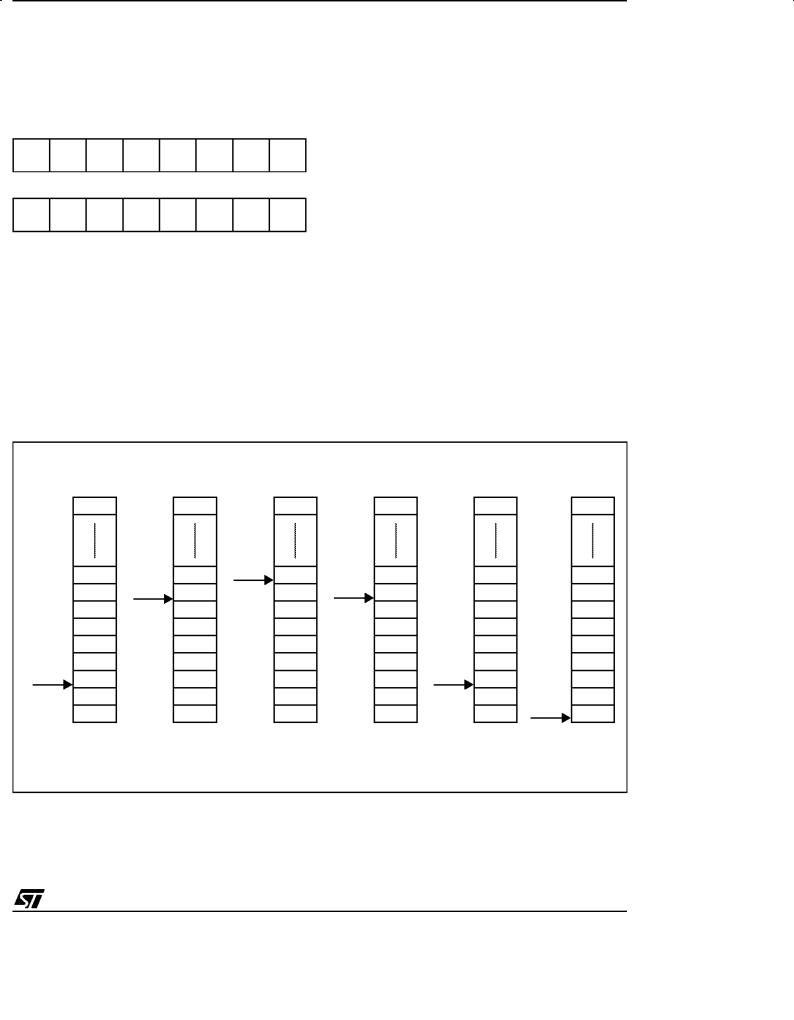
ST72334J/N, ST72314J/N, ST72124J
CENTRAL PROCESSING UNIT (Cont'd)
Stack Pointer (SP)
Read/Write
Reset Value: 01 FFh
15 |
|
|
|
|
|
|
8 |
0 |
0 |
0 |
0 |
0 |
0 |
0 |
1 |
7 |
|
|
|
|
|
|
0 |
SP7 |
SP6 |
SP5 |
SP4 |
SP3 |
SP2 |
SP1 |
SP0 |
The Stack Pointer is a 16-bit register which is always pointing to the next free location in the stack. It is then decremented after data has been pushed onto the stack and incremented before data is popped from the stack (see Figure 11).
Since the stack is 256 bytes deep, the 8th most significant bits are forced by hardware. Following an MCU Reset, or after a Reset Stack Pointer instruction (RSP), the Stack Pointer contains its reset value (the SP7 to SP0 bits are set) which is the stack higher address.
Figure 11. Stack Manipulation Example
CALL |
Interrupt |
PUSH Y |
Subroutine |
Event |
|
@ 0100h |
|
|
|
|
SP |
|
|
SP |
Y |
|
|
|
||
|
CC |
CC |
|
|
A |
A |
|
|
X |
X |
|
SP |
PCH |
PCH |
|
PCL |
PCL |
||
|
|||
PCH |
PCH |
PCH |
|
@ 01FFh PCL |
PCL |
PCL |
The least significant byte of the Stack Pointer (called S) can be directly accessed by a LD instruction.
Note: When the lower limit is exceeded, the Stack Pointer wraps around to the stack upper limit, without indicating the stack overflow. The previously stored information is then overwritten and therefore lost. The stack also wraps in case of an underflow.
The stack is used to save the return address during a subroutine call and the CPU context during an interrupt. The user may also directly manipulate the stack by means of the PUSH and POP instructions. In the case of an interrupt, the PCL is stored at the first location pointed to by the SP. Then the other registers are stored in the next locations as shown in Figure 11.
±When an interrupt is received, the SP is decremented and the context is pushed on the stack.
±On return from interrupt, the SP is incremented and the context is popped from the stack.
A subroutine call occupies two locations and an interrupt five locations in the stack area.
POP Y |
IRET |
RET |
|
|
or RSP |
SP
CC |
|
|
A |
|
|
X |
|
|
PCH |
SP |
|
PCL |
||
|
||
PCH |
PCH |
|
PCL |
SP |
|
PCL |
Stack Higher Address = 01FFh Stack Lower Address = 0100h
23/148
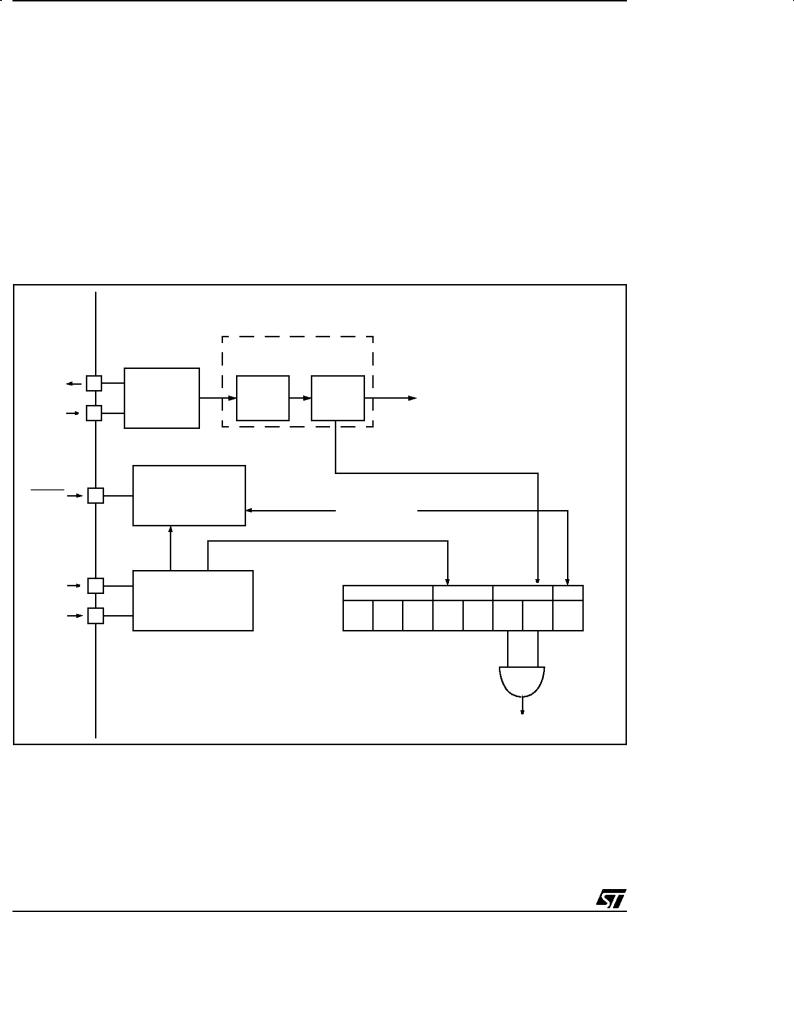
ST72334J/N, ST72314J/N, ST72124J
8 SUPPLY, RESET AND CLOCK MANAGEMENT
The ST72334J/N, ST72314J/N and ST72124J microcontrollers include a range of utility features for securing the application in critical situations (for example in case of a power brown-out), and reducing the number of external components. An overview is shown in Figure 12.
See Section 15 ºELECTRICAL CHARACTERISTICSº on page 105 for more details.
Main Features
■Supply Manager with main supply low voltage detection (LVD)
■Reset Sequence Manager (RSM)
■Multi-Oscillator (MO)
±4 Crystal/Ceramic resonator oscillators
±1 External RC oscillator
±1 Internal RC oscillator
■Clock Security System (CSS)
±Clock Filter
±Backup Safe Oscillator
Figure 12. Clock, Reset and Supply Block Diagram
CLOCK SECURITY SYSTE M (CSS)
OSC2 |
MULTI- |
SAFE |
fOSC |
TO |
|
CLOCK |
|
MAIN CLOCK |
|
|
OSCILLATOR |
|
|
|
OSC1 |
FILTER |
OSC |
|
CONTROLLER |
(MO) |
|
|
|
RESET SEQUENCE
RESET MANAGER FROM
(RSM)
WATCH DOG
PERIP HERAL
VDD |
LOW VOLTAGE |
|
|
LVD |
CSS |
WDG |
|
DETECTO R |
|
|
|||
|
|
|
|
|
|
|
VSS |
(LVD) |
CRSR 0 |
0 |
0 RF 0 |
IE |
D RF |
CSS INTER RUPT
24/148

8.1 LOW VOLTAGE DETECTOR (LVD)
To allow the integration of power management features in the application, the Low Voltage Detector function (LVD) generates a static reset when the VDD supply voltage is below a VIT- reference value. This means that it secures the power-up as well as the power-down keeping the ST7 in reset.
The VIT- reference value for a voltage drop is lower than the VIT+ reference value for power-on in order to avoid a parasitic reset when the MCU starts running and sinks current on the supply (hysteresis).
The LVD Reset circuitry generates a reset when VDD is below:
±VIT+ when VDD is rising
±VIT- when VDD is falling
The LVD function is illustrated in the Figure 13.
Provided the minimum VDD value (guaranteed for the oscillator frequency) is above VIT-, the MCU can only be in two modes:
±under full software control
±in static safe reset
Figure 13. Low Voltage Detector vs Reset
VDD
VIT+
VIT-
ST72334J/N, ST72314J/N, ST72124J
In these conditions, secure operation is always ensured for the application without the need for external reset hardware.
During a Low Voltage Detector Reset, the RESET pin is held low, thus permitting the MCU to reset other devices.
Notes:
1.The LVD allows the device to be used without any external RESET circuitry.
2.Three different reference levels are selectable through the option byte according to the application requirement.
LVD application note
Application software can detect a reset caused by the LVD by reading the LVDRF bit in the CRSR register.
This bit is set by hardware when a LVD reset is generated and cleared by software (writing zero).
Vhyst
RESET
25/148

ST72334J/N, ST72314J/N, ST72124J
8.2 RESET SEQUENCE MANAGER (RSM)
8.2.1 Introduction
The reset sequence manager includes three RESET sources as shown in Figure 15:
■External RESET source pulse
■Internal LVD RESET (Low Voltage Detection)
■Internal WATCHDOG RESET
These sources act on the RESET pin and it is always kept low during the delay phase.
The RESET service routine vector is fixed at addresses FFFEh-FFFFh in the ST7 memory map.
The basic RESET sequence consists of 3 phases as shown in Figure 14:
■Delay depending on the RESET source
■4096 CPU clock cycle delay
■RESET vector fetch
Figure 15. Reset Block Diagram
VDD |
fCPU |
|
RON
RESET
The 4096 CPU clock cycle delay allows the oscillator to stabilise and ensures that recovery has taken place from the Reset state.
The RESET vector fetch phase duration is 2 clock cycles.
Figure 14. RESET Sequence Phases
RESET
DELAY |
INTERNAL RESET |
FETCH |
|
4096 CLOCK CYCLES |
VECTOR |
||
|
INTERNAL
RESET
COUNTER
WATCHDOG RESET
LVD RESET
26/148
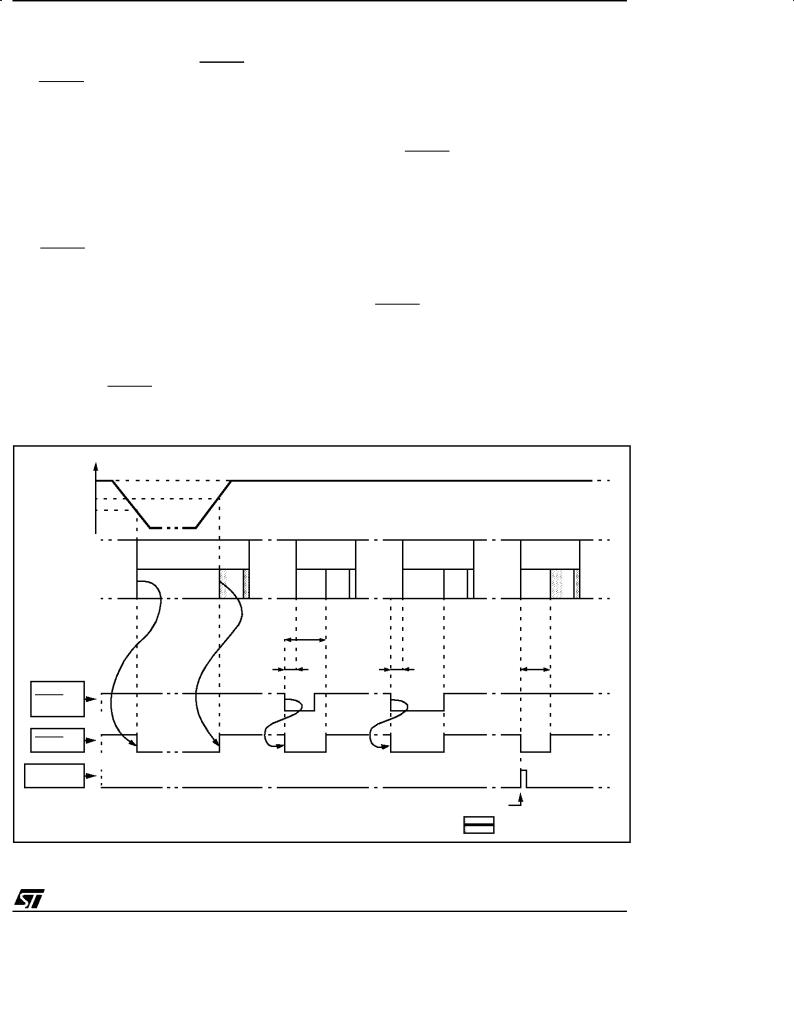
ST72334J/N, ST72314J/N, ST72124J
RESET SEQUENCE MANAGER (Cont'd)
8.2.2 Asynchronous External RESET pin
The RESET pin is both an input and an open-drain output with integrated RON weak pull-up resistor. This pull-up has no fixed value but varies in accordance with the input voltage. It can be pulled low by external circuitry to reset the device. See electrical characteristics section for more details.
A RESET signal originating from an external
source must have a duration of at least th(RSTL)in in order to be recognized. This detection is asynchro-
nous and therefore the MCU can enter reset state even in HALT mode.
The RESET pin is an asynchronous signal which plays a major role in EMS performance. In a noisy environment, it is recommended to follow the guidelines mentioned in the electrical characteristics section.
Two RESET sequences can be associated with this RESET source: short or long external reset pulse (see Figure 16).
Starting from the external RESET pulse recognition, the device RESET pin acts as an output that is pulled low during at least tw(RSTL)out.
Figure 16. RESET Sequences
VDD
VIT+
VIT-
8.2.3 Internal Low Voltage Detection RESET
Two different RESET sequences caused by the internal LVD circuitry can be distinguished:
■Power-On RESET
■Voltage Drop RESET
The device RESET pin acts as an output that is pulled low when VDD<VIT+ (rising edge) or VDD<VIT- (falling edge) as shown in Figure 16.
The LVD filters spikes on VDD larger than tg(VDD) to avoid parasitic resets.
8.2.4 Internal Watchdog RESET
The RESET sequence generated by a internal Watchdog counter overflow is shown in Figure 16.
Starting from the Watchdog counter underflow, the device RESET pin acts as an output that is pulled low during at least tw(RSTL)out.
|
LVD |
SHORT EXT. |
LONG EXT. |
|
WATCHDOG |
|
RESET |
RESET |
RESET |
|
RESET |
RUN |
RUN |
RUN |
|
RUN |
RUN |
|
DELAY |
DELAY |
DELAY |
|
DELAY |
|
tw(RSTL)out |
|
|
|
|
|
th(RSTL)in |
th(RSTL)in |
|
|
tw(RSTL)out |
EXTERNAL
RESET
SOURCE
RESET PIN
WATCHDOG
RESET
WATCHDOG UNDERFLOW
INTERNAL RESET (4096 TCP U)
FETCH VECTOR
27/148
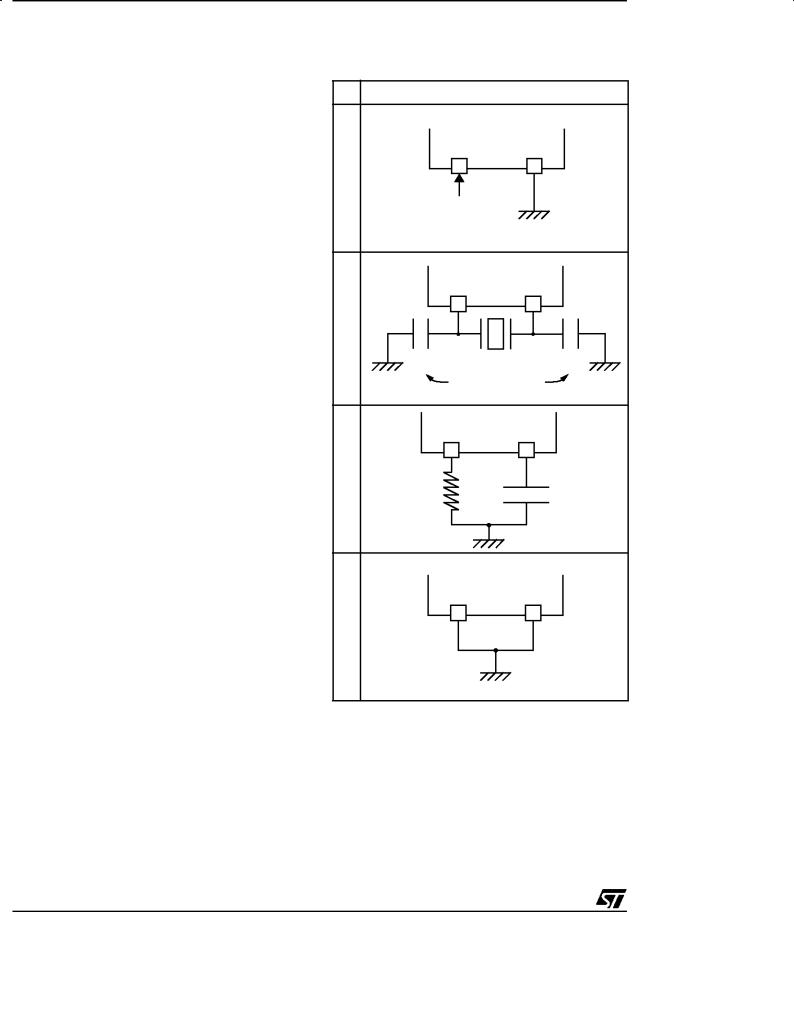
ST72334J/N, ST72314J/N, ST72124J
8.3 MULTI-OSCILLATOR (MO)
The main clock of the ST7 can be generated by four different source types coming from the multioscillator block:
■an external source
■4 crystal or ceramic resonator oscillators
■an external RC oscillator
■an internal high frequency RC oscillator
Each oscillator is optimized for a given frequency range in terms of consumption and is selectable through the option byte. The associated hardware configuration are shown in Table 4. Refer to the electrical characteristics section for more details.
External Clock Source
In this external clock mode, a clock signal (square, sinus or triangle) with ~50% duty cycle has to drive the OSC1 pin while the OSC2 pin is tied to ground.
Crystal/Ceramic Oscillators
This family of oscillators has the advantage of producing a very accurate rate on the main clock of the ST7. The selection within a list of 4 oscillators with different frequency ranges has to be done by option byte in order to reduce consumption. In this mode of the multi-oscillator, the resonator and the load capacitors have to be placed as close as possible to the oscillator pins in order to minimize output distortion and start-up stabilization time. The loading capacitance values must be adjusted according to the selected oscillator.
These oscillators are not stopped during the RESET phase to avoid losing time in the oscillator start-up phase.
External RC Oscillator
This oscillator allows a low cost solution for the main clock of the ST7 using only an external resistor and an external capacitor. The frequency of the external RC oscillator (in the range of some MHz.) is fixed by the resistor and the capacitor values. Consequently in this MO mode, the accuracy of the clock is directly linked to the accuracy of the discrete components.
Internal RC Oscillator
The internal RC oscillator mode is based on the same principle as the external RC oscillator including the resistance and the capacitance of the device. This mode is the most cost effective one with the drawback of a lower frequency accuracy. Its frequency is in the range of several MHz.
In this mode, the two oscillator pins have to be tied to ground.
Table 4. ST7 Clock Sources
|
Hardware Configur ation |
||
ClockExternal |
ST7 |
|
|
OSC1 |
OSC2 |
||
|
|||
|
EXTERNAL |
|
|
Resonators |
SOURCE |
|
|
ST7 |
|
||
|
|
||
Crystal/Ceramic |
OSC1 |
OSC2 |
|
CL1 |
CL2 |
||
|
LOAD |
||
|
CAPACITORS |
||
OscillatorRC |
ST7 |
|
|
OSC1 |
OSC2 |
||
|
|||
External |
REX |
CEX |
|
OscillatorRCInternal |
ST7 |
|
|
|
|
||
|
OSC1 |
OSC2 |
|
28/148
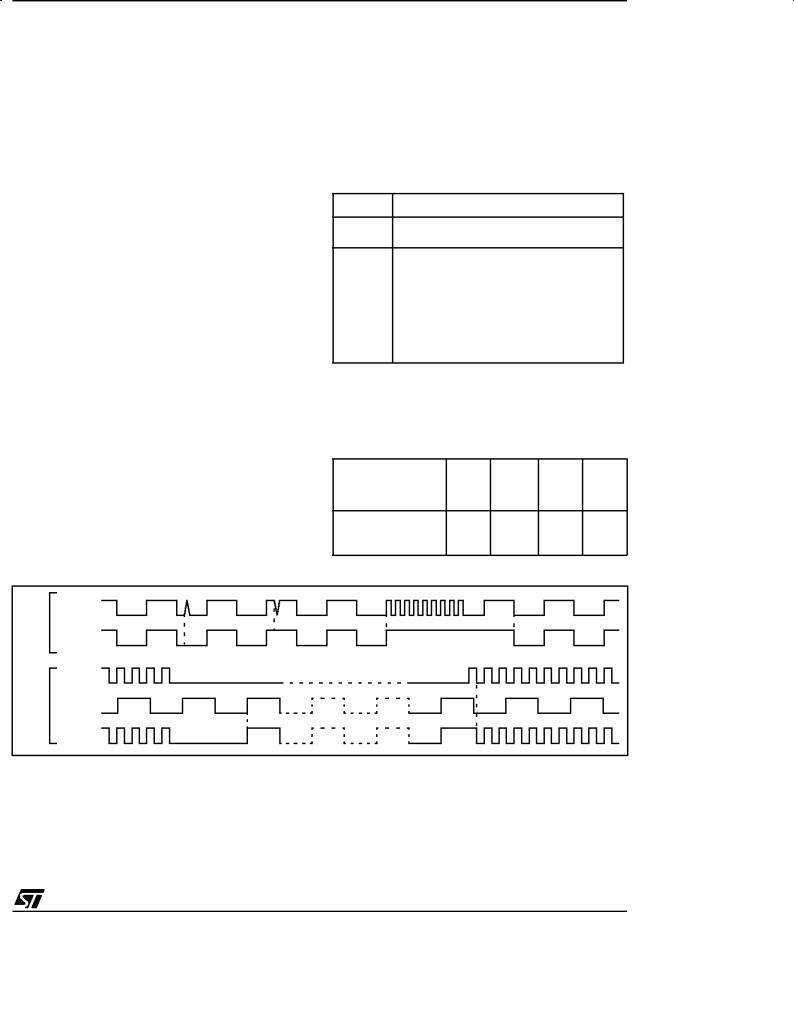
8.4 CLOCK SECURITY SYSTEM (CSS)
The Clock Security System (CSS) protects the ST7 against main clock problems. To allow the integration of the security features in the applications, it is based on a clock filter control and an Internal safe oscillator. The CSS can be enabled or disabled by option byte.
8.4.1 Clock Filter Control
The clock filter is based on a clock frequency limitation function.
This filter function is able to detect and filter high frequency spikes on the ST7 main clock.
ST72334J/N, ST72314J/N, ST72124J
Limitation detection
The automatic safe oscillator selection is notified by hardware setting the CSSD bit of the CRSR register. An interrupt can be generated if the CSSIE bit has been previously set.
These two bits are described in the CRSR register description.
8.4.3 Low Power Modes
Mode |
Description |
WAIT
No effect on CSS. CSS interrupt cause the device to exit from Wait mode.
If the oscillator is not working properly (e.g. working at a harmonic frequency of the resonator), the current active oscillator clock can be totally filtered, and then no clock signal is available for the ST7 from this oscillator anymore. If the original clock source recovers, the filtering is stopped automatically and the oscillator supplies the ST7 clock.
8.4.2 Safe Oscillator Control
The safe oscillator of the CSS block is a low frequency back-up clock source (see Figure 17).
If the clock signal disappears (due to a broken or disconnected resonator...) during a safe oscillator period, the safe oscillator delivers a low frequency clock signal which allows the ST7 to perform some rescue operations.
Automatically, the ST7 clock source switches back from the safe oscillator if the original clock source recovers.
The CRSR register is frozen. The CSS (including the safe oscillator) is disabled until HALT mode is exited. The previous CSS
HALT
configuration resumes when the MCU is woken up by an interrupt with ªexit from HALT modeº capability or from the counter reset value when the MCU is woken up by a RESET.
8.4.4 Interrupts
The CSS interrupt event generates an interrupt if the corresponding Enable Control Bit (CSSIE) is set and the interrupt mask in the CC register is reset (RIM instruction).
|
Event |
Enable |
Exit |
Exit |
Interrupt Event |
Control |
from |
from |
|
|
Flag |
Bit |
Wait |
Halt |
|
|
|||
CSS event detection |
|
|
|
|
(safe oscillator acti- |
CSSD |
CSSIE |
Yes |
No |
vated as main clock) |
|
|
|
|
Figure 17. Clock Filter Function and Safe Oscillator Function
CLOCK FILTER |
FUNCTION |
SAFE OSCILLATOR |
FUNCTION |
fOSC/2
fCPU
fOSC/2
fSFOSC
fCPU
29/148
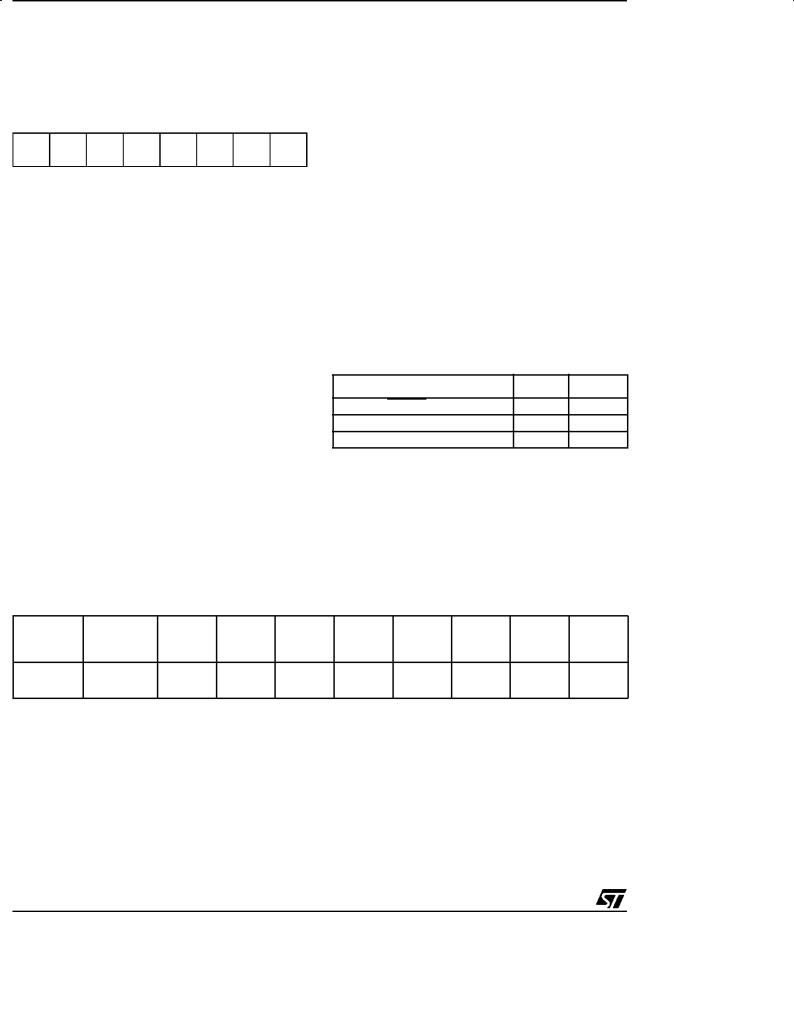
ST72334J/N, ST72314J/N, ST72124J
8.5 SUPPLY, RESET AND CLOCK REGISTER DESCRIPTION
Read/Write
Reset Value: 000x 000x (xxh)
7 |
|
|
|
|
|
|
0 |
|
0 |
0 |
0 |
LVD |
0 |
CSS |
CSS |
WDG |
|
RF |
IE |
D |
RF |
|||||
|
|
|
|
Bit 7:5 = Reserved, always read as 0.
Bit 4 = LVDRF LVD reset flag
This bit indicates that the last RESET was generated by the LVD block. It is set by hardware (LVD reset) and cleared by software (writing zero). See WDGRF flag description for more details. When the LVD is disabled by option byte, the LVDRF bit value is undefined.
Bit 3 = Reserved, always read as 0.
Bit 2 = CSSIE Clock security syst. interrupt enable
This bit enables the interrupt when a disturbance is detected by the clock security system (CSSD bit set). It is set and cleared by software.
0:Clock security system interrupt disabled
1:Clock security system interrupt enabled
Refer to Table 6, ªInterrupt Mapping,º on page 32 for more details on the CSS interrupt vector. When the CSS is disabled by option byte, the CSSIE bit has no effect.
Bit 1 = CSSD Clock security system detection
This bit indicates that the safe oscillator of the clock security system block has been selected by hardware due to a disturbance on the main clock
signal (fOSC). It is set by hardware and cleared by reading the CRSR register when the original oscil-
lator recovers.
0:Safe oscillator is not active
1:Safe oscillator has been activated
When the CSS is disabled by option byte, the CSSD bit value is forced to 0.
Bit 0 = WDGRF Watchdog reset flag
This bit indicates that the last RESET was generated by the watchdog peripheral. It is set by hardware (Watchdog RESET) and cleared by software (writing zero) or an LVD RESET (to ensure a stable cleared state of the WDGRF flag when the CPU starts).
Combined with the LVDRF flag information, the flag description is given by the following table.
RESET Sources |
LVDRF |
WDGRF |
External RESET pin |
0 |
0 |
Watchdog |
0 |
1 |
LVD |
1 |
X |
Application notes
The LVDRF flag is not cleared when another RESET type occurs (external or watchdog), the LVDRF flag remains set to keep trace of the original failure.
In this case, a watchdog reset can be detected by software while an external reset can not.
Table 5. Clock, Reset and Supply Register Map and Reset Values
Address |
Register |
7 |
6 |
5 |
4 |
3 |
2 |
1 |
0 |
|
(Hex.) |
Label |
|||||||||
|
|
|
|
|
|
|
|
|||
002Bh |
CRSR |
|
|
|
LVDRF |
|
CFIE |
CSSD |
WDGRF |
|
Reset Value |
0 |
0 |
0 |
x |
0 |
0 |
0 |
x |
||
|
30/148
